

DIY Cruising Catamaran: Complete Building Guide
As an Amazon Associate, we earn from qualifying purchases. We may also earn commissions if you purchase products from other retailers after clicking on a link from our site.
A brand-new cruising catamaran can set you back a hefty amount of money. However, a DIY cruising catamaran provides a more affordable way to own your own boat. While building a large boat can be an extremely challenging and time-consuming experience, nothing beats the pleasure of bringing your own boat to life.
To build a DIY cruising catamaran, buy good design plans, determine your budget and find a working space. Next, choose your hull material, buy supplies and start building the mast beam. Build and sheathe the hull, install bulkheads, the interior, and finally, launch the catamaran boat.
In this article, you will find a complete guide to building your own catamaran. You will also find detailed information on why you may want to consider building your catamaran and approximately how much this project would cost. Finally, we will explore the advantages and disadvantages of building a catamaran from scratch.
Why You Might Want To Build Your Own Catamaran
Most people might think that purchasing a used boat to repair and fix it up would be cheaper than a DIY cruising catamaran. But while building your own catamaran could be an enormous undertaking, it also comes with many advantages over buying something used.
Other than the unique opportunity to create beautiful memories and experiences while cruising, sailing, and exploring beautiful coastlines, there are a number of benefits that come along with the DIY approach.
Knowing Your Boat
Building your own catamaran provides you with intimate knowledge of your boat. You will know every corner, including where to find every bolt, wire, bulkhead, rib, hose, and support as you installed them yourself. This knowledge will enhance your confidence while at sea since you will have entrusted your life to a boat whose history you are aware of and deeply connected to.
Pride of Ownership
The satisfaction you get from crafting something with your own hands is immense. As a result, the knowledge that you built your boat from scratch will fill you with absolute pride and an immense sense of achievement. Furthermore, as an owner-builder, you get to keep and enjoy the boat for as many years as you wish.
Substantial Cost Savings
Building your catamaran will work out cheaper than buying a new or even gently used boat. Though you will likely require some additional labor since doing some things will require an extra pair of hands, if you are particularly good at DIY, you will save a significant amount of money on labor costs as a whole.
Freedom To Create Your Own Designs
If you decide to buy a catamaran boat, it might not be easy to find one that meets your unique needs. However, instead of choosing from production boats that bear traditional and outdated designs, you can come up with an ultra-modern design or style for your catamaran. You also get to pick your layout, size, and equipment based on your taste and budget.
Great Learning Experience
Building your own boat will help you pick up numerous skills that will come in handy later when sailing your boat. As much as you might still require an expert to help you with specialized skills like carpentry or wiring, your new skills will serve you well. This will also be beneficial when it comes to your boat’s maintenance and fixing things for yourself.
What To Look For in Catamaran Boat Designs
When deciding on the type of catamaran boat to build, you may want to choose a design that’s simple and easy to build. This is because doing so will allow you to spend a shorter time building the boat.
You also need to have a set of requirements to guide you in choosing your design or what you might call an ideal cruising catamaran wish list. This is essential because, ultimately, you want to build a boat that offers outstanding qualities such as:
- Delivers good speed
- Affordable to own and operate
- Agile, strong, and easy to maintain
- Has a high resistance to capsizing
- Great for sailing and cruising
- Delivers a comfortable and easy motion underway
- Good handling ability and high performance under sail
- User-friendly embarking and disembarking
- Provides ample living and accommodation space
- Presents a reasonable resale value
It’s worth noting that, in general, catamaran boats tend to offer a fair resale value mainly because of scarcity and the high price accorded to production models. So, if you build a well-constructed catamaran, you are bound to get a return that’s much higher than the cost of materials upon resale.
It’s also good to consider whether the design you settle on is from an established designer. This is significant because documentation of the building process is just as valuable when it comes to selling the boat.
How Much Would It Cost To Build Your Own Catamaran?
The cost of building your cruising catamaran will depend heavily on the size of the boat you plan to build and the skills you bring to the table. To give you an idea of probable costs, a professionally built 40 foot (12.1 m) long cruising catamaran could go for up to $300,000.
Though building it yourself will undoubtedly be cheaper, most DIY boatbuilders tend to underestimate the expected costs. Your final costs should cover not only the cost of material and equipment but also the labor and time it would take to come up with the final product.
If you were to build a 40-foot (12.1-meter) catamaran, your cost of materials would range between 20-30% of the total cost. Therefore, for $300,000 total, the boat’s materials would range between $60,000 and $90,000. The hull tends to range between 15-35% of the total build. Again, this depends on the finish and furniture.
But before you even start working on the DIY project, you will need to figure out where to do the work. If your home has ample space, then you can opt for a backyard building. But if you live in a small apartment, then you might want to consider renting a small garage at first and then move on to a boatyard later. This is one of the significant costs involved in building your multi-haul.
What You Will Need
To get a clearer picture of how much the entire project would cost, let’s have a look at what else you will need to purchase.
- Good design plans
- Working space
- Ground tackle
- Matting and roving
- Equipment such as the engine, windows, rudders, deck fittings, mast, and rigging
In addition to the above, you also need to install plumbing and electricals. You may also want to consider going electric rather than using diesel. Not only will this drastically reduce your maintenance costs, but you get to use the regenerated power for all of your housing needs while sailing.
Some catamaran boat designs help you save costs by advocating the use of less expensive corpus materials. Most of the material goes directly into making the boat, which means there is hardly any wastage on vacuum bagging . With this method, there are few molds and temporal building forms and fewer fillers to grind off as waste. All these factors reduce the time and cost it takes to build your catamaran boat.
That said, building a boat of any kind is a huge financial undertaking. As such, you still need to have the financial ability to keep building; otherwise, your project will stall or take much longer than anticipated. Instead of enjoying yourself and making memories cruising to faraway lands, you might end up spending all your time building a seemingly never-ending boat.
To reiterate, this project is more of a labor of love, given that it involves a tremendous amount of manual work. Calculating an hourly rate on the time spent building the boat and adding this cost to that of materials may make it seem a very pricey exercise. However, it is vital to understand that your time matters, and every hour you spend working for “free” should be included.
With that in mind, you need to ensure that you are fully devoted to the boat construction project and are sure you want to do it before you begin. Stopping halfway because it seems like too much work would be incredibly costly.
How To Build a Catamaran
When it comes to building a cruising catamaran, you have 3 main options:
- You can buy an old boat and refurbish it.
- Purchase a bare hull plus deck molding for a home-boat building.
- Start from scratch and build everything, including the hull, on your own.
As mentioned above, renovating an existing boat may end up being more costly than starting from scratch. To build a catamaran boat from scratch, follow the below step-by-step guide.
Prepare the Essentials
Before you jump into such a large project, there are several important aspects to consider:
- Buy your plans from an established catamaran designer. You can also get inexpensive, easy-to-build catamaran designs online.
- Get access to a large working space or build a shed . Depending on your climate, you may need to opt for climate control to avoid an excess of moisture in humid areas.
- Decide on your choice of hull material. This could be fiberglass, aluminum, steel, wood, or ferroconcrete.
- Start working on a bill of materials estimate. Include everything that you think you need to get a better idea of the initial costs.
Build the Mast Beam
Using wood and epoxy, cut and glue together the pieces of wood that will form the mast beam. Most of the work at this stage can occur in a garage since it involves building small parts. Still, the work could take up to 4 months, so be prepared to put in long hours.
Build the Boat Hull
Now, it’s time to build the boat’s hull. A catamaran comprises two hulls which are connected with a deck. Below is a short video showing how to build a hull mold:
This work requires a larger facility, so you might need to move out of the garage and into a boatyard. If you don’t have access to a larger workshop, consider building a shed where you can work as you do the construction. Make sure there’s enough room to fit the boat and also allow you to work comfortably. To cover the shed, you can use opaque white tarps.
Sheathe the Hull
Get all the materials you require for this stage in the construction, such as lots of resin, fiberglass, and foam for use in the hull cores. You’ll also require matting and glass roving to sheath the hull .
Sheathing helps to make the hull impervious to water and other marine borers. But first, you need to prepare the hull using a rotary sander. To make it as smooth as possible, use light, sweeping strokes. This is a very dusty task so be prepared to wear a facemask and safety goggles.
Install the Bulkheads
Next is installing the plywood bulkheads . You might need to call in friends to help turn the hulls or use a crane. In this step, you will need to laminate the hull sides on the molded hull panels and bond them above the bulkheads. Ensure the bulkheads are snug and sealed in place.
Construct the Interior Structure
Over the next couple of months, the boat work will involve joining the hulls together with the beams that you had made back in the garage. Then, install the cuddy cabin, decks , and the cockpit . Soon the boat will start to take the shape of a catamaran.
Next, proceed to construct the major structural components such as stairs, hatches, mini-keels, and the interior. Then comes the work of fairing the boat, which is quite labor-intensive.
Finally, it’s time to apply primer on the catamaran boat and start the paintwork. Before painting the boat, you will need to do additional sanding to finish off the two layers of primer as well as fill all the pinholes. Since it’s a large boat, the catamaran has lots of surface area; thus, the sanding could get extremely exhausting—mentally and physically—at this point.
The painting can take a while, too. The hulls are the easiest to paint, but the topsides, non-skid, as well as masking and prepping could seem never-ending.
The final stretch involves working on the center bridge deck cabin and other final touches like installing the engines, electricals, and plumbing. This is also the time to fix the rudders, rigging, mast, windows, and deck fittings.
Launch Your Cruising Catamaran
After many months or years of hard work, your cruising catamaran is finally ready to test the waters. After lowering the boat into the water, check carefully in case there are leaks. If none, you can set up the sails and take your catamaran out for your first cruise.
Below is a short video that takes you through the entire boat-building process:
If you don’t have deep pockets, don’t despair. It’s also possible to build an inexpensive catamaran boat, as shown in this post from the coastal passage .
The Pros of Building a Catamaran
Though it will be a costly endeavor, there are so many things to look forward to should you decide to build your own catamaran:
- It can be lots of fun.
- You get to have a new boat.
- It’s an excellent hobby for DIY enthusiasts.
- The effort is rewarding.
- It offers a great learning experience.
- You get the exact kind of boat you want.
- You can alter building plans and tailor the boat to suit your specific needs.
- It might be cheaper than buying a new boat.
The Cons of Building a Catamaran
Though there are a number of positive aspects to a DIY build, it is just as important to keep in mind that it won’t always be easy:
- Maintenance costs can be quite high.
- It’s both mentally and physically exhausting.
- It might require some technical know-how.
- It can take many months or even years to complete.
- It requires a lot of commitment to finish the DIY project.
- It might be challenging as well as expensive to get insurance.
- You will spend almost all your free time building the boat.
DIY Cruising Catamaran Tips and Tricks
If you are new to boat building, it would be a good idea to build a small boat first. This would give you a good indication as to whether you’d enjoy tackling a more extensive project like building a catamaran. Again, if you are the handy type, fixing your own electronics could also save you a significant amount of money.
Here are more tips and tricks to get the most out of your DIY cruising catamaran:
- Lower your costs. Bring down your costs even further by sourcing for parts and supplies at marine surplus outlets, Craigslist, eBay, or wholesale suppliers.
- Enhance your resale value. Most home-built boats are not easy to sell since they tend to be too customized. To enhance your resale value, it’s advisable to work with a standard design from a well-established naval architect.
- Follow the design instructions. Make sure to follow the designer’s instructions regarding the type of materials and tools to use during the build to avoid making costly mistakes.
- Maintain your original budget. Avoid any additional customizations once you have started building the boat. Using good plans and sticking to them ensures that your budget doesn’t spiral out of control.
Final Thoughts
Building a catamaran is about more than saving money. It’s fun, exciting, fulfilling, and can be a great learning experience. While it might take many months of back-breaking work, comparative shopping and sourcing for materials will help you save a lot of money. Still, at the end of it all, you’ll have a beautiful catamaran boat, all ready for your first cruising adventure.
However, if you have neither the time nor the energy to build your own catamaran from scratch, refurbishing an existing hull might prove faster and easier. It also works out much cheaper than buying a new boat.
Owner of CatamaranFreedom.com. A minimalist that has lived in a caravan in Sweden, 35ft Monohull in the Bahamas, and right now in his self-built Van. He just started the next adventure, to circumnavigate the world on a Catamaran!
One thought on “ DIY Cruising Catamaran: Complete Building Guide ”
Hello, I am a French Quebecer who is original, imaginative, creative and who finds that all boats and catamarans have a huge flaw and a very big lack of logic. I would have a brand new concept…. I am sending this message to any catamaran creator – designer to make those who have the opportunity and the intelligence to want to know about my innovative idea which will finally upset the market much richer. An idea that will totally change the concept of sailing, navigation and save so much worry!! All I would ask for is a small percentage of each sale of the new product. To be able to make me produce one when I have enough!! It is certain that like that, you just want to tell me: come on Mr. Lessard give us your idea but do not take your word to help me in return! But, if you are the kind of man to have only one word and maybe have a proof of your good faith if the realization of the project would make it… I will be very happy!! Giving it to everyone wouldn’t bother me either…. all I would like is to be able to find flax fiber (too expensive carbon) to be able to try to make my catamaran myself. Because not rich! Have a nice day and looking forward to having a message!!
Leave a Reply Cancel reply
Your email address will not be published. Required fields are marked *
Save my name and email in this browser for the next time I comment.
Recent Posts
Must-Have Boat Gear for Catamaran Sailors!
Sailing is probably the most gear-intensive activity I've ever done; there are so many decisions to be made about what gear to buy now, for tomorrow, and what to definitely never buy. The gear on...
6 Best Trailerable Trimarans For Bluewater and Coastal Sailing
Having a boat costs a lot of money, even when you are not using it, marina fees, etc. And once it is in the water most sailors never go very far from their "home marina" and sailing will be somewhat...

MIKE WALLER
Yacht design, multihull boat plans by mike waller yacht designer.
TC670 TRAILER CAT This is an all plywood, trailerable, of the beach sailing cat designed for sheltered and semi-sheltered waters. The cabin has a double berth, a galley, small table area and W.C.

TC750 CATAMARAN This all plywood cat is a larger and more able development of the 670, and being wider, is capable of more extensive adventuring.
W880 CATAMARAN This true ocean going little cat sleeps 4 and is built in strip plank cedar and glass composite, and plywood. Sleeps 4, and has a seperate WC / shower area.
%20-%20Copy.jpg)
W1100 CATAMARAN This Ocean cruising vessel is in all plywood, and is capable of extensive ocean voyaging. Sleeps 5 in three seperate cabins, with seperate W.C / shower area.
W1160 CATAMARAN This ocean crusing family cat is built from strip plank cedar and glass composite. She sleeps 5 in 3 cabins and has a seperate WC / shower area.

W1200 CATAMARAN This ocean cruising family cat is a plywood version of the 1160, with rounded, strip planked hull bottoms and the rest of the boat in plywood. The transom is slightly extended to provide a wider boarding step.
W1350 CATAMARAN This is a family cruiser in cedar/foam/glass composite, intended for world cruising for a couple or small family

W1480 CATAMARAN This is a true, proven, live aboard world cruiser for a family of up to 6 in four cabins. The vessel is strongly constructed in strip plank cedar and glass composite, and plywood. She will take you anywhere.
CS25 CATAMARAN This little demountable cat has two seperate hulls, each with two berths. She is all plywood.

CS35 CATAMARAN This cat has two seperate hulls with V shaped truncated sections, each has a double berth. She is all plywood and has a center cockpit which can be built in to form a shelter cuddy.
CC31 CATAMARAN This full bridge deck cat is in multi-chine plywood, and has two huge double berths, a dinette and seperate WC / shower area

CC40 CATAMARAN This ocean voyaging cat is in multi-chine plywood, and has two seperate hulls, a center cockpit with cuddy, and unbelievable accomodation for a vessel of this type and size

How To Build A Catamaran? (A Step-By-Step Guide)
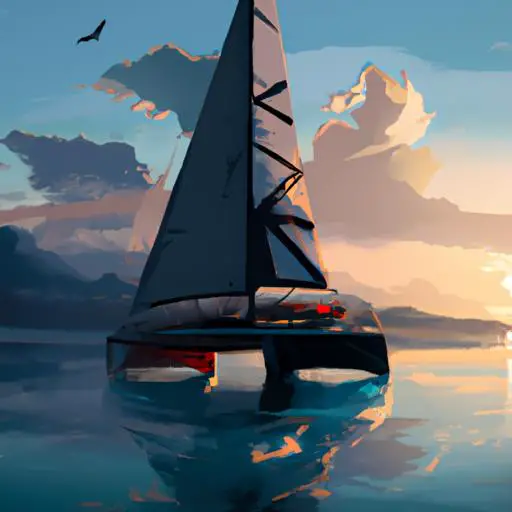
Are you excited about the prospect of building your own catamaran? With a little research, planning, and the right tools, you can turn your vision into reality in no time.
In this step-by-step guide, well show you how to make the most of this incredible boatbuilding project.
From selecting the materials and planning the design to constructing the hulls and deck and outfitting the boat, well walk you through everything you need to know to build a catamaran of your own.
So, grab your tools and lets get started!
Table of Contents
Short Answer
Building a catamaran requires careful planning and a lot of patience.
The first step is to decide on the design and the materials you will use.
You will need plans for the project, along with lumber and other materials such as fiberglass and epoxy.
The next step is to build the catamaran frame, which involves cutting and fitting the wood pieces together to form the hulls and decks.
Finally, you will need to attach the decking, add the rig and sails, and finish the project with paint and varnish.
Benefits of Building a Catamaran
Building a catamaran can be a very rewarding experience.
Not only will you have the satisfaction of creating something with your own hands, but you will also have a boat that is uniquely yours.
Catamarans offer many benefits over traditional monohull boats, making them an ideal choice for those looking for a reliable and efficient ride.
These benefits include greater stability, more space, improved fuel efficiency, and greater speed.
Stability is one of the biggest advantages of catamarans.
The two hulls provide a wider base that helps to keep the boat from rocking and rolling in rough waters.
This makes for a much smoother and safer ride, even in choppy waters.
Additionally, the two hulls create an open area between them that is perfect for storing equipment, making it ideal for longer trips.
Catamarans are also more fuel efficient than monohulls.
This is because the two hulls provide lift, allowing the boat to glide through the water more easily.
This means you won’t need to use as much fuel to power your boat, allowing you to save money in the long run.
Finally, catamarans are faster than monohulls.
This is due to the increased surface area of the two hulls, which allows the boat to move more easily through the water.
This makes them ideal for those who want to travel quickly and efficiently.
Overall, building a catamaran can be a fun and rewarding experience.
With the right materials and tools, you can create a boat that is unique to you and offers many benefits over traditional monohull boats.
With the right planning and construction process, you can create a catamaran that will be the envy of your peers.
Selecting the Materials

Selecting the right materials is a crucial step in building a catamaran.
The type of material you choose will depend on the size and type of catamaran you are building, as well as your budget and experience.
Catamarans are typically constructed from wood, aluminum, or fiberglass.
Each of these materials has unique advantages, so it is important to research the pros and cons of each before making a decision.
Wood is the traditional material used to build catamarans and is often the most cost-effective option.
Wooden catamarans are strong and stable, and they can be custom-built to any size or shape.
However, wood requires a lot of maintenance and can be susceptible to rot and water damage.
Aluminum is a great option for larger catamarans, as it is lightweight and resistant to corrosion.
It is also relatively easy to work with and can be welded together to create a strong and durable structure.
However, aluminum is a more expensive material and is not as flexible as wood or fiberglass.
Fiberglass is the most popular material for building catamarans, as it is lightweight, strong, and resistant to corrosion.
Fiberglass is also relatively easy to work with and can be shaped to create unique designs.
However, fiberglass is also the most expensive option and can be difficult to repair if damaged.
Once you have selected the material, it is important to purchase the right amount for the project.
Make sure to measure the catamaran carefully and purchase enough material to account for any mistakes or waste.
It is also important to purchase high-quality materials that will last for years.
With the right materials, you can build an amazing catamaran that you will enjoy for years to come.
Planning the Design
When planning the design of your catamaran, youll need to consider a variety of factors, including the size, shape, and type of material youll be using.
Consider the size and weight of the catamaran and the type of water it will be used in.
Youll also need to think about how the catamaran will be used, such as for recreational or commercial purposes.
When it comes to the shape of the catamaran, the most common design is the two-hulled V-shape.
This shape is ideal as it offers stability and is easy to maneuver.
However, depending on the type of use, other shapes, such as the three-hulled catamaran, may be better suited.
The material you choose for your catamaran will also play a role in the design process.
Common materials used to build catamarans are wood, fiberglass, aluminum, and composites.
Each material has its own advantages and disadvantages, so its important to research and select the best material for your project.
Finally, when planning the design, youll need to consider the outfitting of the boat.
This includes items such as decking, seating, and a helm station.
Make sure to think about the type of equipment youll need for your catamaran, and consider how it will be installed.
By taking the time to plan the design of your catamaran, you can ensure that you get the best possible outcome.
Doing your research, selecting the right materials, and choosing the right outfitting will all help you create an amazing catamaran that will last for years to come.
Constructing the Hulls and Deck

Constructing the hulls and deck of a catamaran is perhaps the most important and time-consuming step in building a catamaran.
You will need to plan the design of the hulls and deck carefully to ensure that your catamaran is strong, stable, and seaworthy.
When constructing the hulls, you will need to use strong and light materials that are suitable for marine environments.
Fiberglass is a good choice for this, as it is strong and lightweight.
You will need to cut and shape the fiberglass to fit the shape of the hulls, and you will need to use a strong adhesive to bond the pieces together.
The deck of the catamaran will need to be strong and stable enough to support the weight of the passengers and cargo.
You will need to construct the deck out of marine-grade plywood, and you will need to use a strong adhesive to bond the pieces together.
You may also need to add extra support beams to the deck for added strength.
Once the hulls and deck have been constructed, you will need to sand and finish them to ensure a smooth and watertight surface.
You may need to use a sealer or primer to protect the wood and fiberglass from the elements.
Finally, you will need to attach the hulls and deck together.
This can be done with bolts, screws, or other fasteners.
You may also need to use a water-resistant sealant to ensure a watertight connection between the hulls and deck.
Outfitting the Boat
Outfitting a catamaran is an essential part of the build process.
Once the hulls and deck are constructed, you’ll need to ensure that all the necessary components are in place for a successful voyage.
This includes items such as masts, sails, rudders, and outriggers.
It is critical to ensure that the boat is outfitted with the right components for its size and purpose.
For example, if you are building a small catamaran for speed and agility, you’ll need to outfit it with a light and responsive mast and sail.
If you are building a larger craft for comfort and luxury, you’ll need to outfit it with a heavier and more resistant mast and sail.
Additionally, you’ll need to select the right outriggers and rudders for the catamaran’s size and purpose.
Outfitting a catamaran can be a complex process, and it is important to do the research and plan ahead.
Taking the time to select the right materials and components will ensure that your boat is outfitted for success.
Additionally, it is important to use quality materials and components to ensure a safe and successful voyage.
With careful planning and quality components, you can outfit your catamaran for a successful journey.
Acquiring the Right Tools

When it comes to building a catamaran, having the right tools can make all the difference.
To get started, you’ll need a variety of hand tools, including saws, drills, sanders, and screwdrivers.
You’ll also need power tools like routers, biscuit joiners, and angle grinders.
It’s also important to have safety equipment like safety glasses, ear protection, and respirators.
You’ll also need a variety of measuring tools, such as rulers, calipers, and tape measures.
Finally, you’ll need a selection of glues, adhesives, epoxies, and sealants.
With the right tools, you’ll be able to complete your catamaran project safely and efficiently.
Researching and Planning Your Build
Researching and planning your build are essential steps in the process of building a catamaran.
The first step is to become familiar with the design and construction of catamarans.
Start by researching different types of catamarans, from the small and lightweight recreational boats to the larger and more luxurious cruising vessels.
Learn about the advantages and disadvantages of the different types of catamarans and determine which type is best suited to your needs.
Once you have a good understanding of the different types of catamarans, you can begin researching the materials and tools you will need for your project.
You will need to choose the type of wood you will use for the boats hulls and deck, as well as the type of fiberglass and resin you will use for the hulls and deck.
You will also need to choose the type of engine you will use and the type of rigging and sail you will use.
Once you have selected the materials and tools you will need for your project, you will need to create a plan for the construction of your catamaran.
You will need to determine the size and shape of your boat, the types of joints you will use to construct the hulls and deck, and the type of engine and rigging you will need.
You should also plan out the sequence of construction steps, so that you can build the catamaran in the most efficient way.
Finally, you will need to research the best ways to protect your catamaran from the elements.
You will need to determine what type of paint or varnish to use on the hulls and deck, and you will need to research the most effective ways to protect your boat from the sun, wind, and water.
By taking the time to research and plan your build, you will be able to create a catamaran that is well-built, efficient, and beautiful.
With the right research and planning, you can create an amazing catamaran that will be the envy of your friends.
Final Thoughts
Building a catamaran is a rewarding experience that can be achieved with the right approach and materials.
With a clear plan, the right tools, and a good understanding of woodworking and fiberglass techniques, you can build an amazing catamaran to share with your family and friends.
So what are you waiting for? Get started on your own catamaran build today and all the rewards that come with it!
James Frami
At the age of 15, he and four other friends from his neighborhood constructed their first boat. He has been sailing for almost 30 years and has a wealth of knowledge that he wants to share with others.
Recent Posts
Does Your Boat License Expire? Here's What You Need to Know
Are you a boat owner looking to stay up-to-date on your license requirements? If so, youve come to the right place! In this article, well cover everything you need to know about boat license...
How to Put Skins on Your Boat in Sea of Thieves? (Complete Guide)
There is a unique sense of pride and accomplishment when you show off a boat you customized to your exact specifications. With Sea of Thieves, you can customize your boat to make it look like your...
production Strider 24
plywood Romany 34
lightweight 14ft Zeta mainhull
Strike 15 trimaran at speed
28ft Skoota in British Columbia
10ft 2 sheet ply Duo dinghy
24ft Strider sailing fast
36ft Mirage open deck catamaran
- All Our Designs
- For new visitors
- About Richard Woods
- Useful Articles
- Testimonials
- Plan Updates
- Links to Owners and Suppliers
- Consultancy Service
- Boats for Sale
- Blog and Facebook Posts
- Our Cruising Blog (updated Jan 26th 2020)
- Download Eclipse logbook (300 page pdf)
- Download Newsletters 1992-2002 (pdf)
- Download Year Reviews 2002-14 (pdf)
- Download FAQs (pdf)
- Download Boat Tests (pdf)
Welcome to this, the Woods Designs web site which we hope you will find is an interesting and useful introduction to our range of boat designs.
Based in the UK, Woods Designs is run by Richard Woods and specialises in the design of multihulls for both home and professional builders. Founded in 1981 we now boast possibly the most comprehensive range of catamaran designs in the world.
Click here for stock designs, which range in size from 8' to 38' and types include beach catamarans, open deck cruising catamaran, bridgedeck cabin cruisers, racing catamarans and trailable boats. We also have six small trimaran designs, eight power cats and a few dinghies. Over the years we have designed a number of one-offs, up to 70ft, so if you don't see your ideal boat here please contact us with your requirements and we may be able to help you with an unlisted design.
Click on the photo, right, or use the link in the heading menu, to see the complete list.
Boats can be built in a range of materials of which the most popular include sheet ply, cold moulded ply, strip plank cedar and foam sandwich. Like most designers we do not offer plans for catamarans built in steel or aluminium.
Nearly 3000 plans and over 200 production catamarans have now been sold. Boats are sailing all over the world. Cruisers have made many comfortable ocean crossings in complete safety while the number of trophies won is testament to the speed of the racing designs.
This site is now very large, so please use the Search Button top left to help you navigate round the site.
<div class="statcounter"><a title="joomla statistics" href="http://statcounter.com/joomla/" target="_blank"><img class="statcounter" src="http://c.statcounter.com/8565636/0/19698e94/1/" alt="joomla statistics"></a></div>
Modular Wooden Catamaran

Introduction: Modular Wooden Catamaran

Ahoy, fellow Instructables users!
Do you dream of waves running alongside wooden hulls? Do you crave the scent of salty sprays? Do you grin at the thought of striding along some foreign shore?
Well, if you'd like any of that, this probably isn't the project or century for you. This Instructable provides a brief account of a 10ft by 5ft modular catamaran I constructed and successfully sailed on a small lake.
Step 1: Draftsmanship

After poking around online for inspiration and taking heavy influence from the crafts of Jeremy Broun and Tim from Way Out West , I drafted plans for my catamaran. My design, alas, was limited by my amateur woodworking skills and my available tools, leading it to be quite heavy and boxy. On the positive side, though, the craft ended up being as durable as a brick, which would have been difficult to accomplish with thinner plywood or stitch and glue construction.
The plans call for the craft to be built in four pieces. This isn't ideal for structural stability, but, lacking a trailer, I had to constrain the total volume to what could be held in the bed of my truck. To hold all the pieces of the hull together, I later created a deck with two by sixes and 11/32nds inch plywood but chose to forego drawing plans for this so that I could account for whatever warping developed in the wood.
Step 2: Construction

I constructed the craft over a period of about two months one the basis of one quarter at a time. After constructing the first two sections, though, I realized that giving priority to the horizontal members of the frame lead to unwanted slanting, so I modified my design and gave priority to the vertical members of the frames in the latter two quarters.
In a previous and regretful experiment in boat construction, I had build a spectacular failure of a sailing dinghy. I had intended to redeem myself by fitting my second boat to sail, hence the rudder mechanism. I decided against using the wind for locomotion in the end out of a combination of time constraints, design constraints, fear of repeating past mistakes, and general laziness. Thus, I outfitted the boat with a Motorguide T42 trolling motor and 12V deep cycle battery for propulsion.
Step 3: Maiden Voyage

And so it happened: the maiden voyage. The Kaspar Röist cruised well on the calm lake waters without any leaks or structural failures. That is all for now.
Recommendations

Remake It - Autodesk Design & Make - Student Contest

All Things Pi Contest

Made with AI - Autodesk Design & Make - Student Contest

[email protected]

Category: Our Catamaran Build Kits
Recommended equipment.

Quality suppliers & manufacturers
The schionning team have a lot of contact with equipment suppliers and manufacturers, and hear feedback on certain brands or systems from our many customers. there are many schionnings cruising the world and testing products longevity and the customer service offered by the manufacturer., on this page we will list products and companies that we know to provide above average quality and service. it is always growing, and if your company provides equipment used on our designs and you would like to be included - please contact us., engines & drive systems.

Visit: https://oceanvolt.com
Batteries, Power Management

LITHIUM POWER (VIC)
Back in 2013 I knew that my boat batteries were reaching the end of their lives, I had been researching LiFePO4 cells for a few years and decided that I should install them. Unfortunatly I was unable to find a local supplier. So Lithium Power was established.
Technical Information
The technical information page is a collection of documents (mostly in pdf format) on the materials and systems used in schionning catamarans. including data sheets, engineering information, strength comparisons of each core material and informative articles from jeff outling the design of certain system such as engine choices and main sheet systems., detailed engineering data for your research, we understand that getting your head around the process of building your own boat, or having one built, can take a little while. to gain a greater understanding of the materials used in our designs, the below data sheets have been supplied by atl composites, and contain all of the technical data you could need regarding the composites we use. in addition are articles or documents written by jeff about certain systems used on our designs and why., all technical information and data sheets on west system/duflex/durakore provided courtesy of atl composites. for more information please see the atl composites website here., documents library.
Information Sheet – CE CERTIFICATION PROCESS
- Mainsheet Systems for Catamarans
- Motor Choices for Schionning Designs
- Weight and Weight Distribution Schionning Designs
- Schionning Designs Sailing Performance and Tips
- Hull Shapes and Performance – Power Designs
- Outboard Engines VS Diesels – Written by Ross McCombe
- An Outboard Installation That Works – Ross McCombe Follow up
- Data Sheet – DUFLEX BALSA for Catamaran Kit Builds
- Data Sheet – DUFLEX FOAM
- Data Sheet – FEATHERLIGHT Paper Honeycomb
- Data Sheet – WEST SYSTEM R105
- Data Sheet – PUMP SYSTEMS
- Data Sheet – MICROFIBRE BLEND 403
- Data Sheet – MICROLIGHT 410
- Data Sheet – MICROSPHERES 411
- Information Sheet – USING FILLERS
- Data Sheet – KINETIX RESIN Thixotropic
- Information Sheet – DURAKORE PLANKS 413
- Data Sheet – DURAKORE PLANKING 414
Kit Materials Contents
Kit materials' contents, so if you order a schionning kit, what exactly is going to arrive see an overview of the materials you will receive, and what each is used for during the build process. fibreglass cloth or tapes microspheres, microballoons or microfibers take a closer look and you can answer these questions., our schionning kits are a no nonsense, common-sense approach to building a boat. we offer great service, fast delivery and access to anything you could need for your boat straight from the supplier to your door. our construction plans and kits are sold with 100% professional boatbuilder support via phone and email, any time you're unsure or just need a second opinion, we're here..
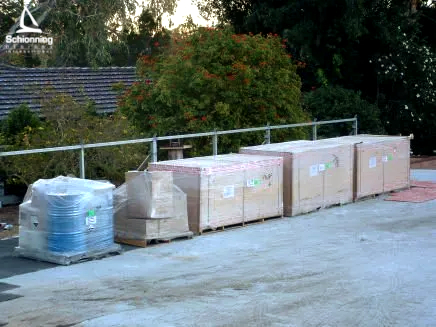
Our kits contain all of your basic materials to build your boat to a faired shell stage, ready for painting and fit-out. We have sail-away costing estimates available for all of our standard designs, and this will give you an accurate idea of the overall cost of your project. This costing varies depending on your level of finish, as you can imagine different options vary greatly in price.
Below is a quick glance at what your Schionning Kit will include and what each item is primarily used for, we hope this is helpful and if you should require more detailed information please don’t hesitate to contact our office.
What do I actually receive?
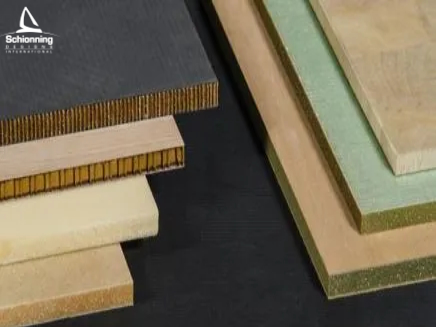
DUFLEX PRE-LAMINATED PANELS
DuFlex pre-laminated panels are the main and most important material used in our kits, predominantly in the flat panel designs, however they are used in Strip-planked designs also, though to a lesser extent. These panels are 2400mm x 1200mm and are CNC routed to speed up build time on our Wildernes X Series, as well as some of our power designs. For internal furniture, a paper honeycomb core is used instead of the end-grain balsa wood core that is used for main structural areas. The use of this is purely to save weight in the shell and therefore produce a faster, more responsive catamaran.

KINETIX LAMINATING RESIN & HARDENER

WEST SYSTEM EPOXY RESINS

FIBREGLASS TAPES (DOUBLE BIAS)
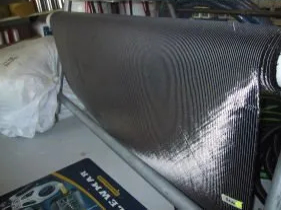
CARBON FIBRE CLOTH

FIBREGLASS CLOTH
The kit process, building your own boat can be a daunting prospect, however to demonstrate each step in the kit assembly process, we've created this guide for you to study. as you can see our kits are the ultimate in building efficiency and have been streamlined over 30+ years to ensure that you're on the water faster and with less effort., how does it all go together.
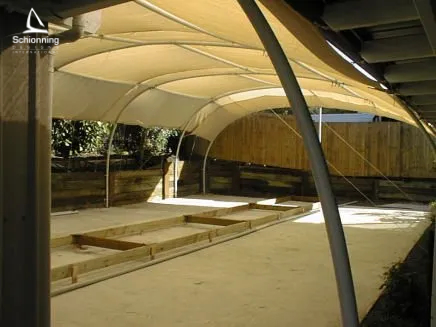
The first step to building your dream catamaran begins with a strongback – this is a square frame used to position the temporary frames that will be used to form the hull shape. This frame will be set up and must be square and accurate, a string or laser level can be used to achieve this.

The forebeam is now installed along with the striker attachment fitting, as shown above. The bridgedeck is installed shortly after and taped onto the bulkheads with webs installed, this now completes what is a quite stiff and strong platform to work on.

Now that the bridgedeck is in place, the forward webs and dash will be fitted. At this stage, all furniture and internal work begins, with the main panels left off for ease of access when working.
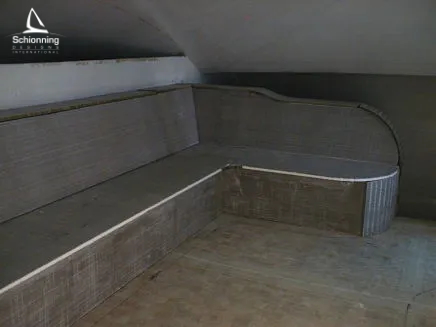
Material Choices
Schionning material choices, solutions that work best for catamarans & why, our designs are based on cored composite construction techniques using west system epoxy resin and knitted fabrics. but given the range of today's composite technologies, which solution works best for catamarans and why written by jeff schionning, selecting the correct materials, resin choices.

It also fully protects the boat against water absorption and it can not develop the dreaded Osmosis.
We choose ATL Composite’s resin systems for their superior quality, reliability and value for money.
Having worked closely with the ATL Composites team and their products for many years, we know we can stand by their material solutions, and rely on great service should something unexpected happen.

This may not seem important but when working with a material for an extended period of time, the small things make all the difference.
CORES Which One to Use?

- End-Grain Balsa – 150kg per cubic metre
- Superlight Balsa – 94kg per cubic metre
- Western Red Cedar – 360-380kg per cubic metre
- Foam – 80kg per cubic metre
BALSA END GRAIN (150 kg/cubic metre)
Balsa has very good values and we can produce a shell using a very light laminate. It will be very stiff and very resilient to fatigue.
It has exceptional qualities including very high compression strength, extremely good sheer capabilities and fantastic sheer stiffness.
Compressive strength is the resistance to collapsing when pressure is applied perpendicular to the surface as when pushing directly onto the material with the point of your finger. Balsa is far stronger than Foam (80kg/cubic metre) in compression.
Balsa is also very strong in shear. This is when the core sample is held flat between your hands, one hand slid one way and the other slid the opposite way, when the core tears through the middle the core has failed in sheer. The amount of stretch you feel before the core shears is shear stiffness. To compensate for sheer weakness the core is made thicker. So 13mm Balsa may be equal in sheer to 19mm Foam.
(80 to 200 kg/m³)
There are many boats sailing that are built from foam as it’s mechanical properties are good for boat building.
- Initially one would expect this cat shell to be lighter as it is ½ the weight of Balsa. We do have to compensate for its weaknesses and will then add to the reinforcement the reinforcement on the outside to spread that compression load over more core and need a triaxial type weave to compensate for the veneer content that runs fore and aft on the Durakore.
- Secondly, we need to increase the Core thickness to compensate for the shear value, usually neutralizing the weight advantage.
- We only use structural foam core that is closed-cell and cross-linked.
The end result using foam core amounts to a very similar total boat weight. Professional builders can achieve a good result but usually use vacuum bagging and very good molds to achieve this.
Secondary Issues
Balsa can absorb water. It needs extreme neglect to rot (very unusual). Water soaks along the end grain quickly. It travels very slowly across the grain. We use balsa under the waterline especially because of it’s high compression strength for beaching etc. any core type must be sealed. Damage to all cores results in the same sort of repair. Notice a damp spot remaining when drying out to anti-foul… simply grind back the surface glass exposing the core, dry it out and re-glass – it’s that easy.
Timber cores are cheaper than Foam in most cases.
A light, high tech cat returns a far better (often 2 – 3 times) re-sale than lower tech materials. Often saving $10,000 on materials initially, loses $200,000 on re-sale – a serious reality.
Our boats can be built using Balsa, Foam or Western Red Cedar. Combine strength, stiffness, lightness and cost, with ease of use – it just makes good sense!
- Row boat plans
- Sailboat plans
- Power boat plans
Strider by Woods Designs
The "classic" trailable catamaran.
URL: http://sailingcatamarans.com/index.php/designs/2-catamarans-under-25ft/165-strider
Description:
STRIDER is the most popular of our trailable catamarans as it offers a good compromise between speed, accommodation and low cost.
Striders are very good sea boats and have competed successfully in tough offshore races. A racing version, the Turbo , with wider beam, increased rig size, rotating mast etc. is available for those who's aim is to race at the highest level or who sail in a very light wind area.
The 4 berth interior layout is as on the Shadow .


Photo gallery
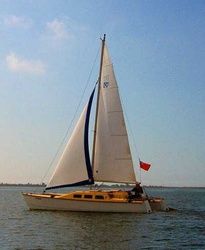
Video gallery

Catamarans about same size as Strider
Questions? Suggestions? Contact us at: [email protected]

James Wharram Designs
Search Our Site
Self build boats.
- Professionally Built Boats
- Choosing a Boat
- How We Design
- Photo Gallery
- Video Gallery
- Articles & Blogs
- Wharram World
A philosophic attitude behind the Wharram designs is that 'urban man' can, with a little financial saving and some handcraft work, create an object of beauty. This object of beauty can then, for a period of hours, days, weeks or months, carry him/her out of the urban world into a natural never-never land; the seas and oceans; to a time when the world was young; when Mankind was directly and intimately interacting with the beauty and power of nature. There are hundreds/thousands of Wharram builders or, as I prefer to call them, "Sea People", who have done or are now doing that!" - James Wharram
A well built Wharram design is a 'Functional Kinetic Sculpture'" - Hanneke Boon

Everything you need to build your own sea-going catamaran: 3 steps
- Familiarise yourself with our range of designs and their unique qualities. For more detailed information read the Wharram Design Book which reviews each self-build boat model and offers a detailed introduction and understanding of the world of self-build catamarans.
- Order one or more sets of our Study Plans and immerse yourself into the boat builder's mindset; evaluate the costs; the amount of time required to build your boat; where you will build it and where you will eventually launch it.
- Once you have decided on the boat that is right for you to build, order the Boat Building Plans and become a member of the global family of Wharram builders and sailors. You can build a Wharram with very little experience . All Wharram building plans are drawn for the first time builder, so anyone with a modicum of practical ability can build one of our designs. Our Building Plans present quality instruction, guidance and advice for both novice and professional alike. They are all based on decades of actual building experience and thousands of ocean miles sailed, so you can be confident in your boat's capabilities and safety.
Tiki Designs

Coastal Trekkers To Long Term Live Aboards
From the car trailable Tiki 21 - winner of the 1982 Cruising World Design Competition, to the Tiki 46, a spacious ocean cruiser or charter boat, the TIKI range offers car trailable coastal trekkers to long term live aboards . Although a Tiki 21, a very popular coastal trek design, has circumnavigated, we would not recommend this for everyone! A number of Tiki 26s have also made ocean crossings, but again this is only for the experienced sailor. The larger TIKI designs of 30ft and over are craft capable of longer voyages and ocean crossings. They are designed to be less costly to build by using appropriate wood/epoxy technology and by eliminating, wherever possible, expensive metal fittings common to modern yacht design.
On the larger TIKIs the 'Deckpod' offers sheltered steering and the 'Stern Ramp' provides easy access to and from the water. The TIKIs are boats you can work and live on. The Wharram approach goes beyond simple boat design - the concept of 'Flexispace' puts emphasis on not just the physical living area, but also the 'mind space' of those on board.
Hitia Designs
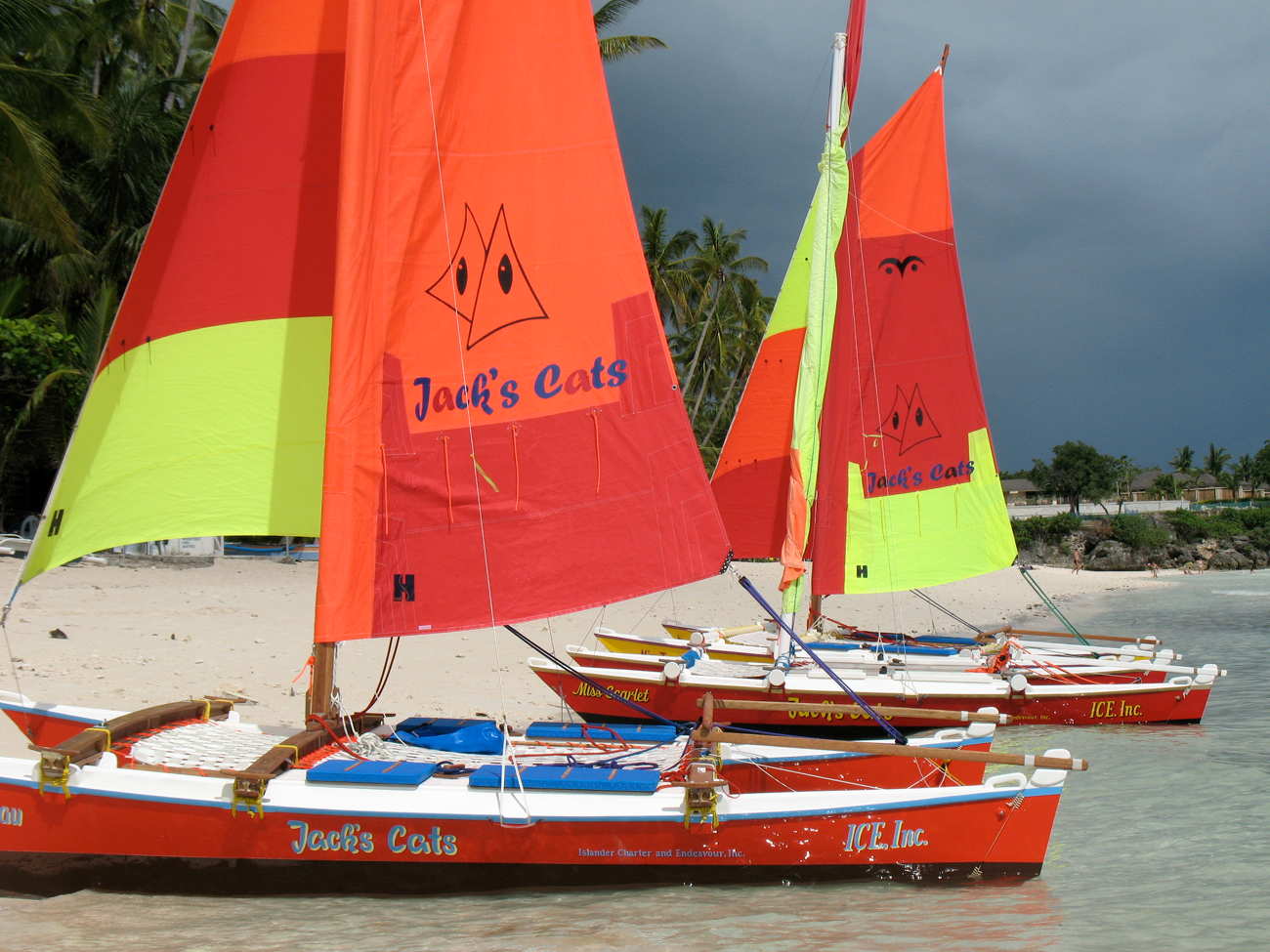
Affordable Weekend Adventure Boats
The Hitia Designs are the perfect beach catamarans . They are 'coastal trekkers' and cater for those who do not want a craft for long distance or "blue water" sailing, but would like to be able to trail their boat to varied interesting coasts and lakes. Their easy economical construction, stability and speed makes for affordable weekend adventure boats . The Hitia 14 can be carried on the roof of your car and fits on the deck of a larger boat. The Hitia 17 has more stowage space and room for a tent on deck for longer excursions. These boats are ideal for small adventures and coastal treks.
Introducing: the Mana 24 'Cat Kit'
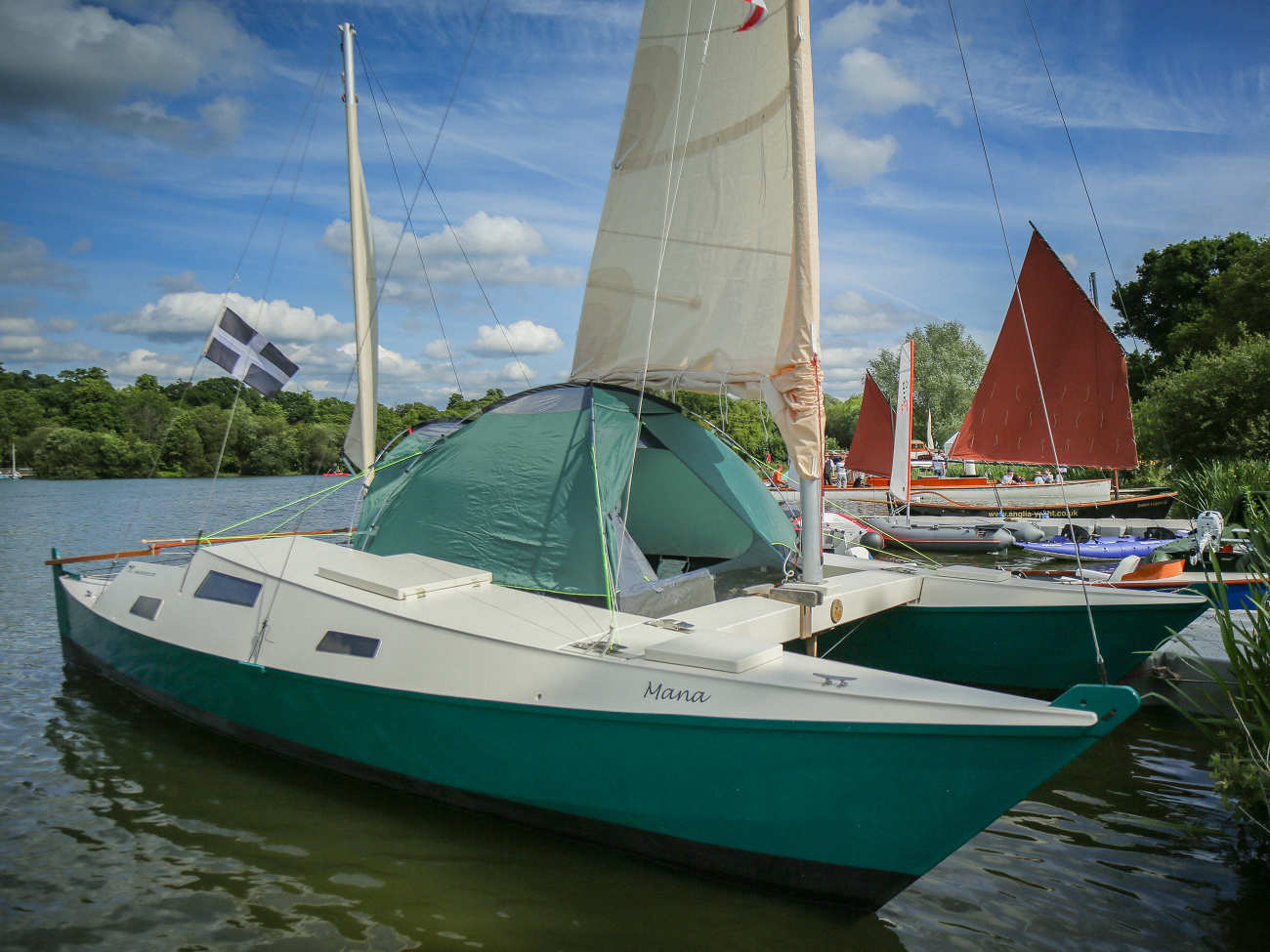
Boat In A Box
The MANA kit is sold with all the plywood cut out by CNC cutter and pre-coated with epoxy, so building the boat at home will be a bit like assembling a flat-pack . All the parts slot together perfectly so a hull can take shape in a day. Building from such a kit takes away the worry of measuring and cutting all the boat parts , which can be quite daunting to many first time builders and saves a lot of time in the early stages of building. In designing the MANA, we looked sideways into the world of camping and have combined the innovative CNC cut "flat pack" boat-building concept with the philosophy of outdoor living to create the unique MANA camper-sailer, specifically designed for trailer sailing.
The ply parts will have a first smooth coat of epoxy already applied, cutting down time in coating and sanding, so within a short time you will be able to assemble the hulls and see the boat you are building. As she is built from a pre-cut kit, we have been able to give the Mana more complex and beautiful shaping, giving her more interior volume than the Tiki designs.
Pahi Designs

The More Evocatively 'Female' Of The Wharram Designs
From the Coastal Trekking Pahi 26 to the impressive 63' flagship of the Wharram fleet 'Spirit of Gaia' - the PAHI shape is more evocatively 'Female' than the Classic Wharram designs. They are a different visual/sculptural approach to the basic design elements inherent in the Classic Designs. Constructively, they are simpler to build, using epoxy fillets instead of more difficult wood joints . They are designed to use quick growing softwood plys, coated and glassed with epoxy to achieve a durable finish. The PAHI designs were the first to use rope lashings to attach the crossbeams, giving a shock absorbing effect, without the need for metal fittings. 'Pahi' in Polynesian dialects means 'ship'.
The Pahi 42 'Captain Cook' design set fresh ocean cruising standards when she was designed in 1979. The Pahi 63 was designed in 1986 and launched in 1992 to become the new ocean going flagship for the Wharram family. During the construction of 'Spirit of Gaia' many unique new solutions to plywood and epoxy building methods were developed, which were later incorporated in the larger TIKI and ISLANDER designs.
Ethnic Designs
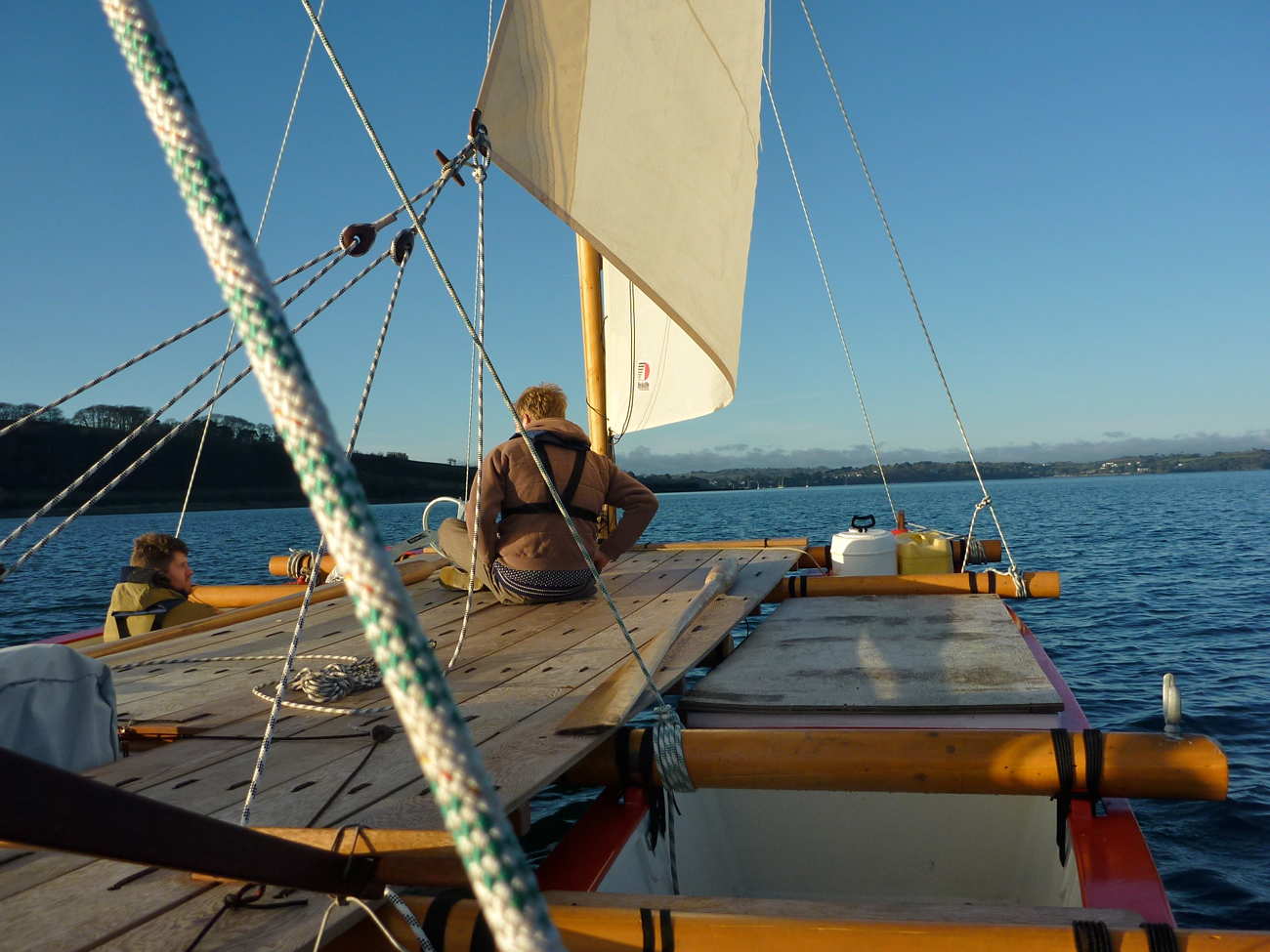
Traditional Pacific Sailing Craft
The Ethnic designs have been a new development at James Wharram Designs since James and Hanneke sailed extensively in the Pacific. With everything self-made these boats are lower cost to build . They cater for those who want a "traditional" Pacific sailing craft, built using appropriate modern materials and methods, but without trying to Westernise them. These designs arose after requests from Pacific Island peoples for James to design craft to overcome shortages of "traditional" building materials, but which closely reflect the cultural and ethnic origins of these craft.
Classic Designs
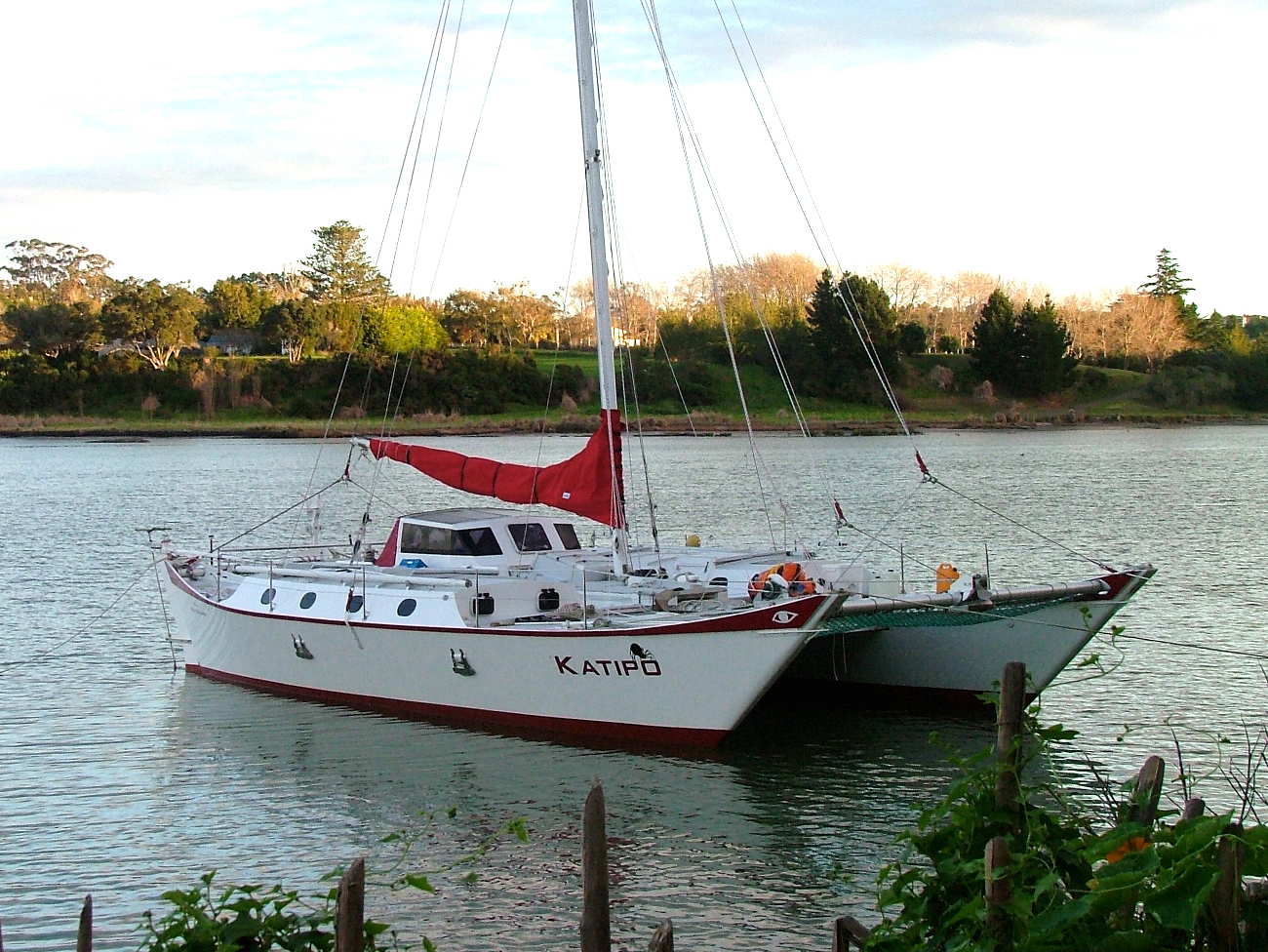
The Early Wharrams - Sturdy and Stable
The early 'Wharrams', now known as the Classic Designs, are recognised as beautiful, safe boats - easy to build, and easy to sail . Many anchorages around the world are graced by these Classic Designs, and of the seventeen drawn between 1957 and 1976, nine are still available, from the 16ft Maui to the 51ft Tehini. They were the first range of Wharram catamarans, designed in the 1960s and 70s, based on the sea experience of James Wharram's pioneering ocean crossings. They are sturdy, very stable, but relatively basic in design. They are built using simple plywood construction over a backbone and bulkhead frame .
HOME / INDEX PAGE

Tokyo Express
- Small Boats
- Geelong Model 850
- Plans (all)
- Noosa Plans
- Tewantin Plans
- Geelong Plans
- Daggerboard Plans
- Daggerboards
- Consulting / Drafting
- Terms & Conditions
- Privacy Policy
Select Page
Catamaran & Small Boat Building
to my website. Here you’ll find photos, stories and information on building boats large and small, with tips and tricks I’ve picked up along the way. I built this website originally to accompany my YouTube channel . The blog section has information on various topics.
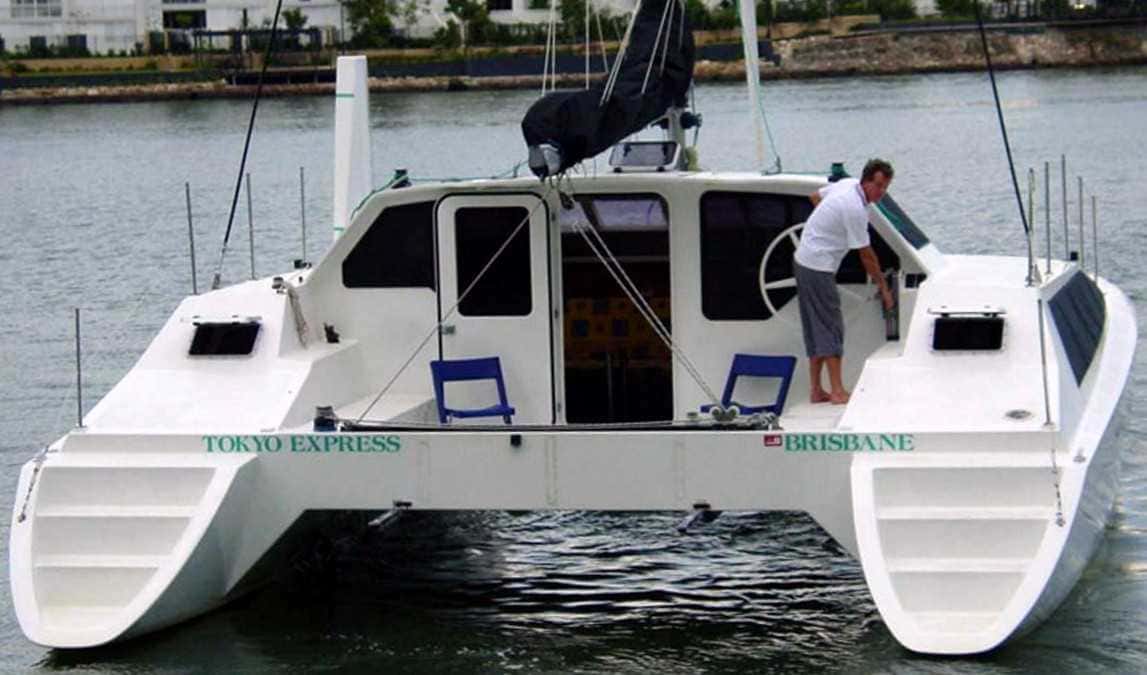
A 12m cruiser/racer catamaran – 2 yrs & 9 mths to build – launched 15th August 1997. Details of the build.
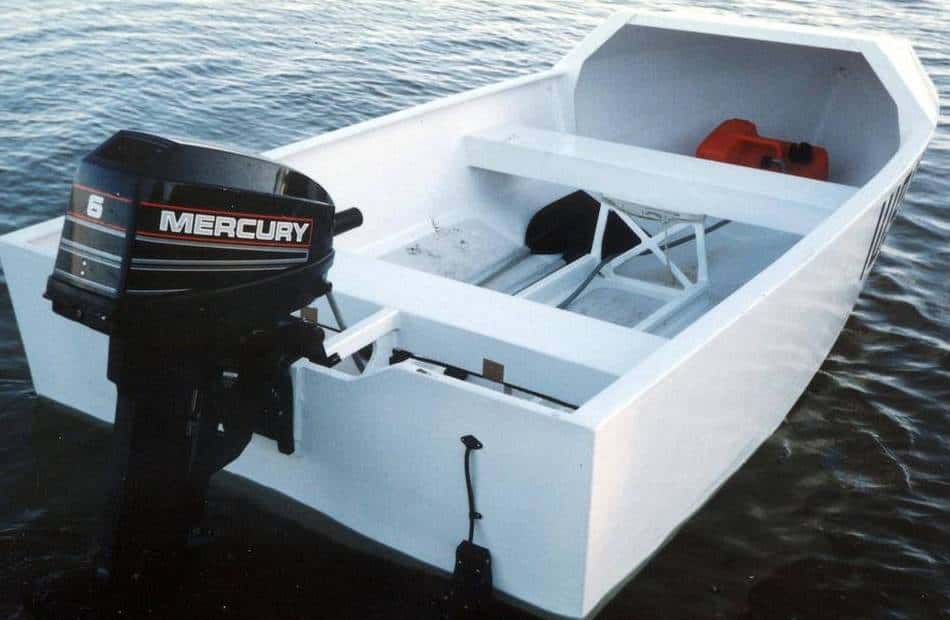
Small boats
Small boats you can build in your garage. A good family project and a way to get a taste of boat building. See how they were built.
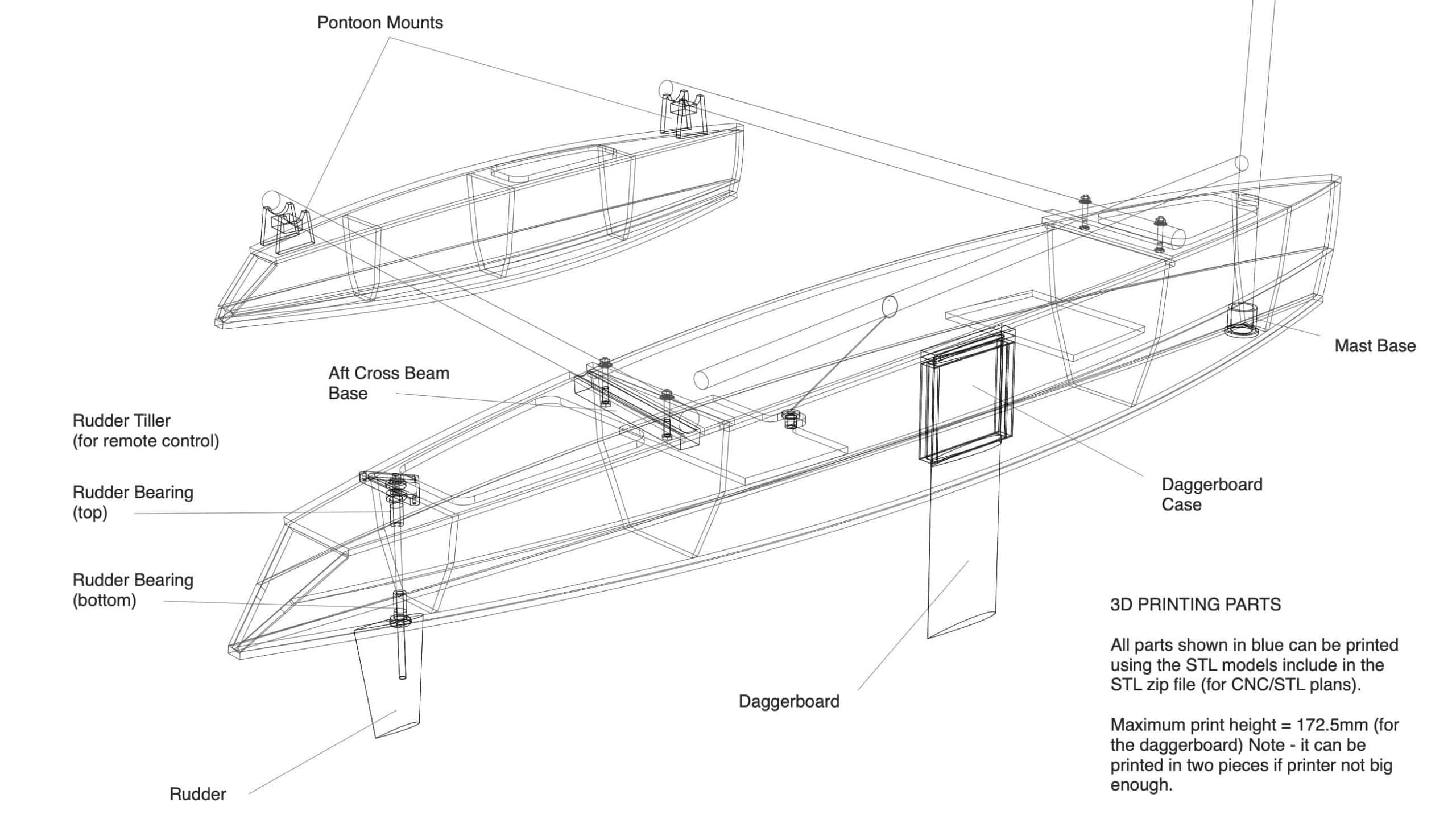
Plans to build your own boat. Packed with information for the first time builder. Start building your boat now.
Where to start
Building your own boat and sailing off over the horizon, is a dream that lives inside many. Well at least that’s the impression I get from the many people I met while building Tokyo Express (TE) and the feedback now f rom the videos on YouTube. After years of dreaming, at 39 years of age I finally turned that dream into reality with the launching of Tokyo Express. This website is about my journey.
You don’t need expensive kits
or exotic materials to build a boat. You don’t need expensive tools or a degree in engineering either. I fabricated most of the parts and systems on Tokyo Express (TE) from scratch. Steering system, steering wheel, doors, hatches, fore beam, catwalk, daggerboard, rudders, engine mounting, generator, electrical system and plumbing.
Even the mast I bought as a kit. I had more time than money so I built everything I could. There were no exotic materials used and yet I ended up with a robust, lightweight and extremely competitive boat that was lighter than a typical production boat.
If I hadn’t been designing and redesigning many parts of the boat, learning for the first time how to do things and building a shed, the boat would have been finished a lot quicker.
On the Tokyo Express page
page you will find an overview of the steps I took building TE. If you are thinking of starting a similar project, this is a good place to start. It was a lot of work, but it was also the most rewarding project I have undertaken. It was well worth the sweat and tears. Please look around. Email me if you have questions…
Recent Posts
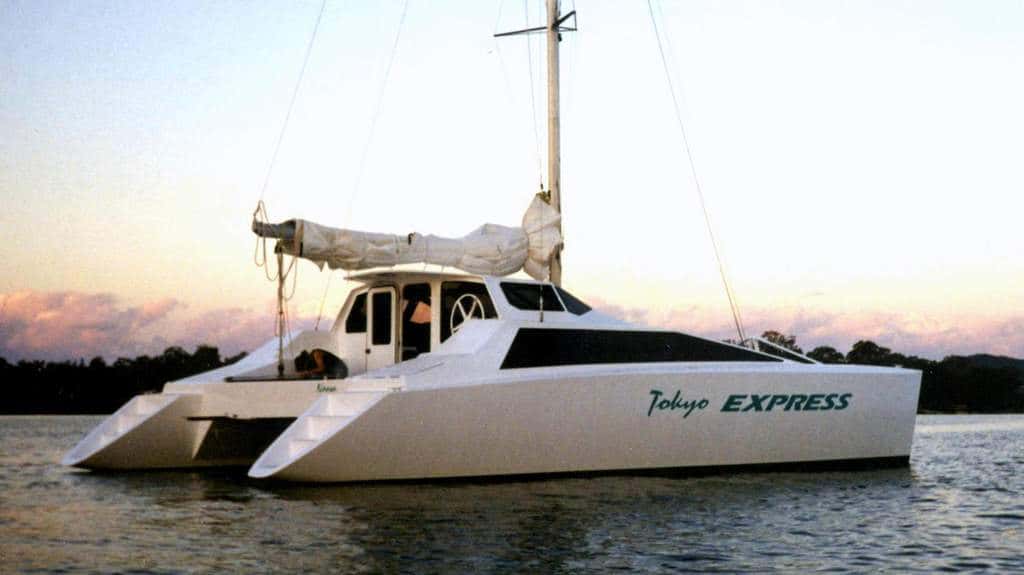
- Catamaran vs Monohull
by Tim Weston | Mar 11, 2019 | Building , Cruising
Catamaran vs Monohull If you are thinking of building or buying a yacht, you have a significant choice to make, before you even start looking at individual boats. Do you want one hull or two? Deciding between a catamaran and a monohull is a big decision and one worth...
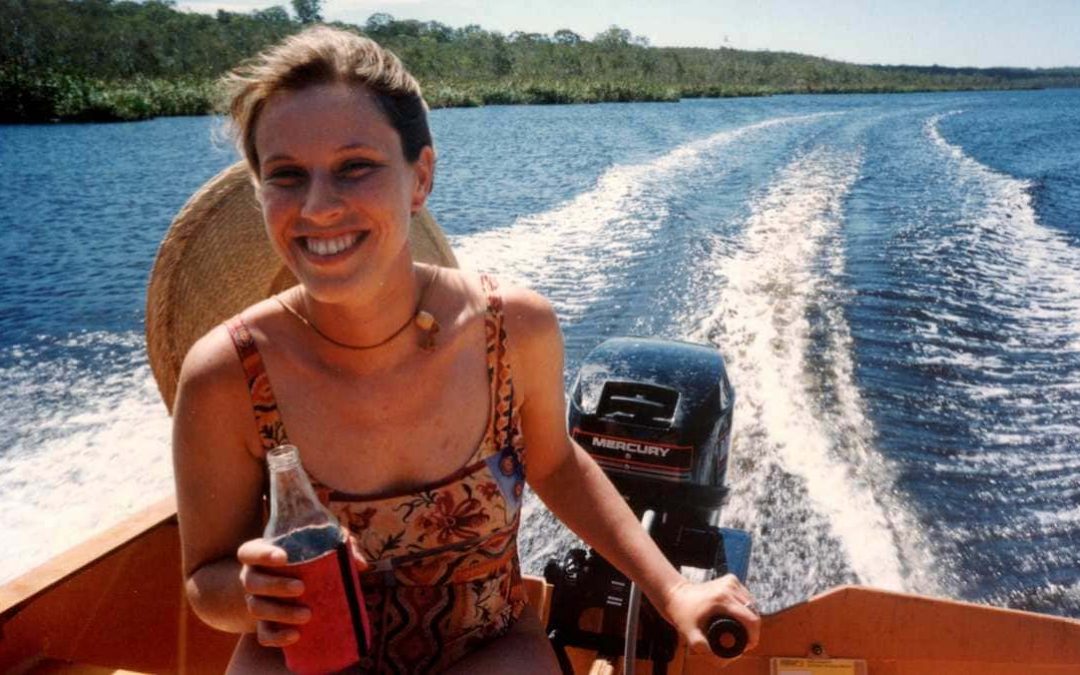
- Going fast – in small boats – hull speed.
by Tim Weston | Sep 30, 2018 | Building , Plans
Going fast - in small boats (with a small motor) This article looks at how to go fast, in a boat with a small motor. Plodding along at snail’s pace can get a little boring. No matter how relaxed I am and how much time I have nothing puts a smile on my face quicker...
Search Site
New book – just released.
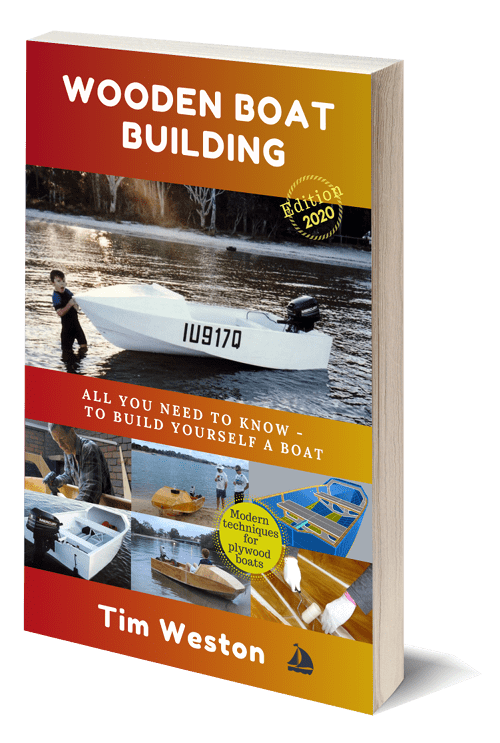
Watch the Video Series – (1 hour & 45 mins)
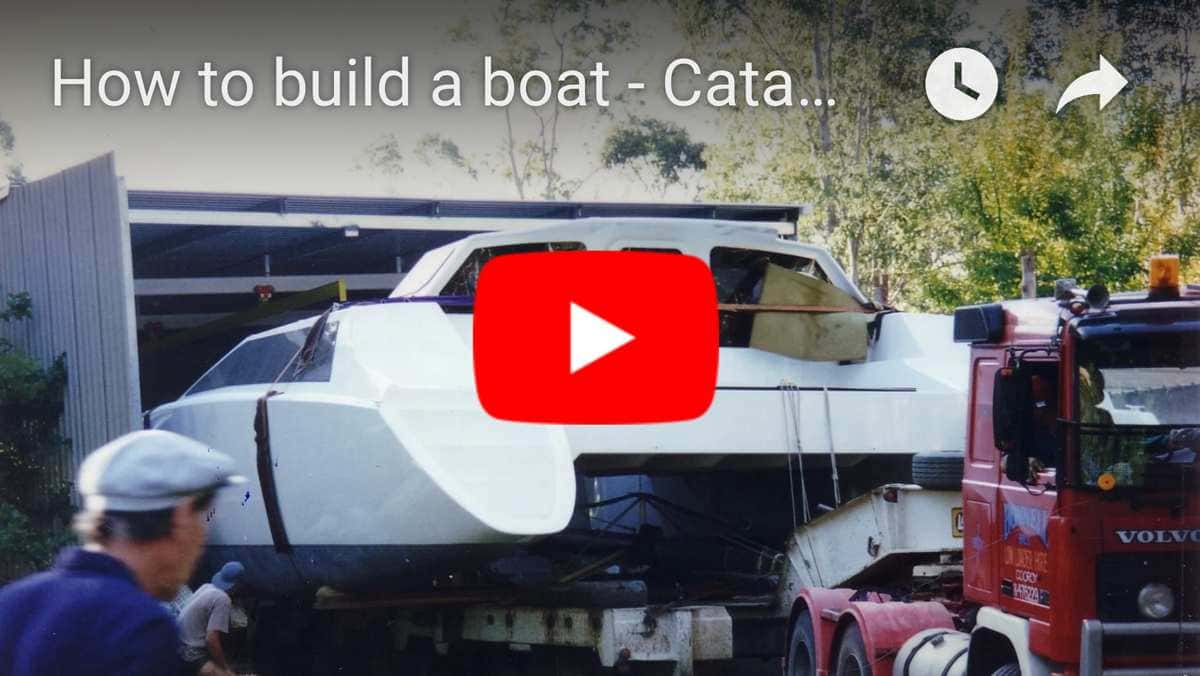
- Keeping safe – while building your boat
- Catamaran size – how big a boat do you need – ocean sailing
- How much does it cost to build a boat – a 40ft Catamaran?
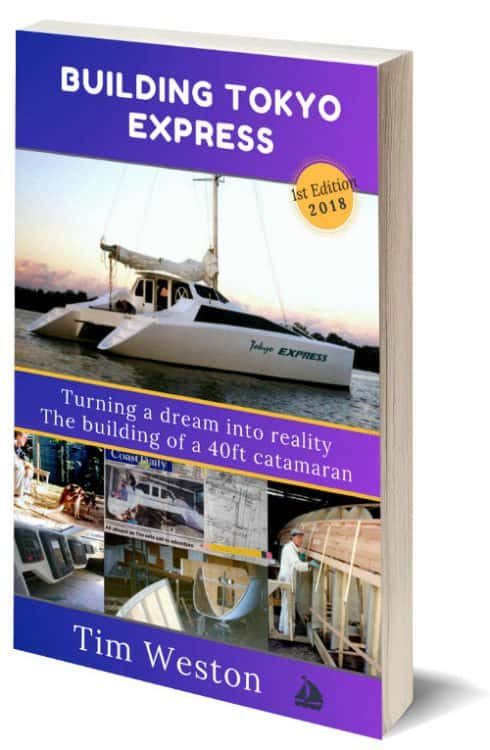
Get the Guide – Free
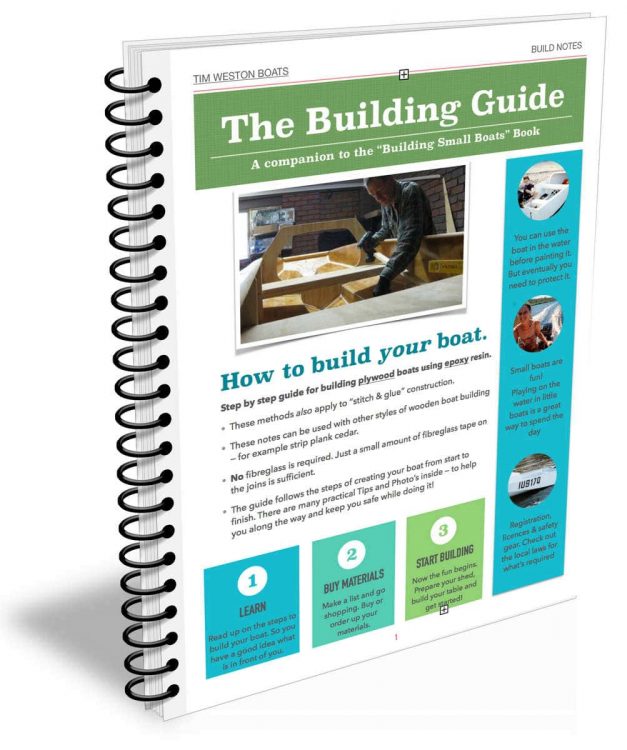
Tim Weston Boats
2022©timwestonboats.com
[email protected]
Privacy Overview
March / April Issue No. 297 Preview Now
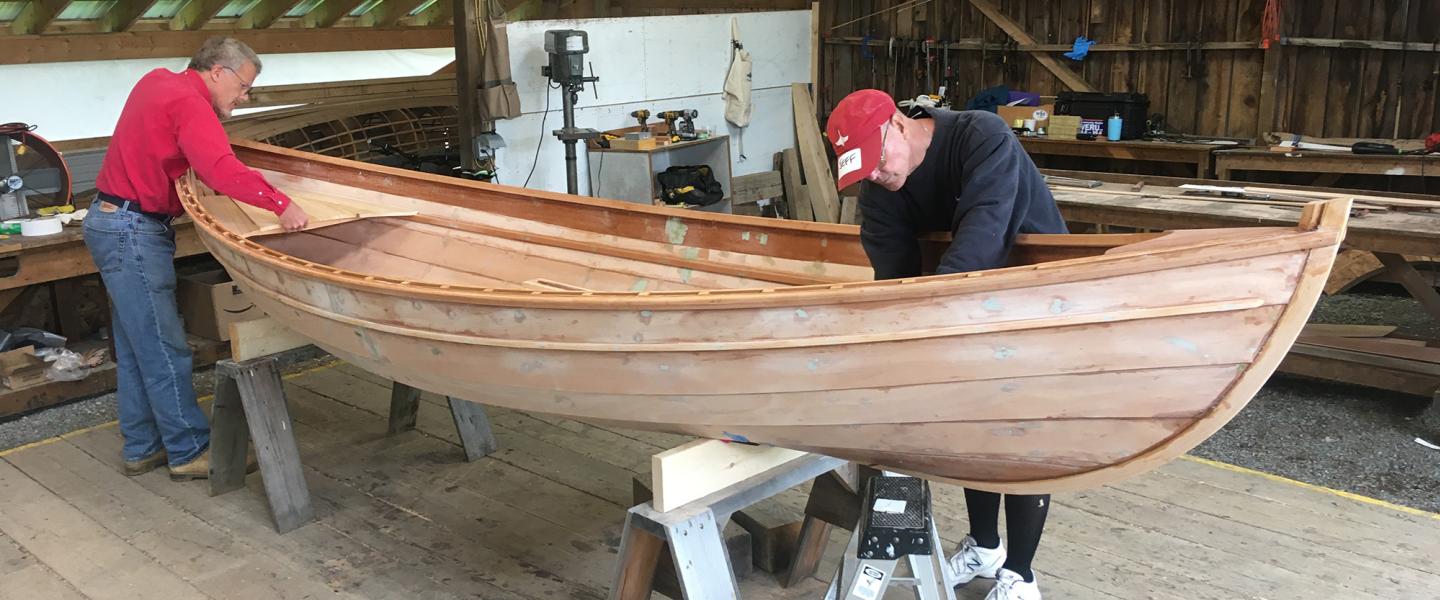
Plans & Kits
If you’re in the market for a boat to build, this directory of Boat Plans & Kits is a fine place to start. And if your company sells plans or kits, we invite you to list your offerings here. There is no charge for listing, but the featured boats must be built of wood. To refine your search of this directory, use quotation marks. If you search Nutshell Pram Kit, you’ll receive all the listings that include the words Nutshell, Pram, and Kit. To refine your search, enter “Nutshell Pram Kit”; you’ll then see only the results for Nutshell Pram kits.
Post Your Boat Plans & Kits
Post Your Plans/Kits login or register
Search plans & kits.
To refine your search, add quote marks. If you search Nutshell Pram Kit, you will get all the listings which include Nutshell, Pram, and Kit. To refine, search “Nutshell Pram Kit” and you’ll see just Nutshell Pram Kit results.
715 Results
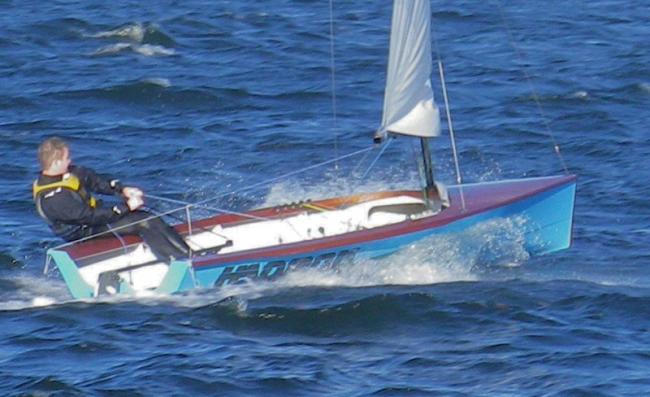
Sailboats - Racing
Hadron singlehander racing dinghy.
HADRON is a new dinghy design for 2011.
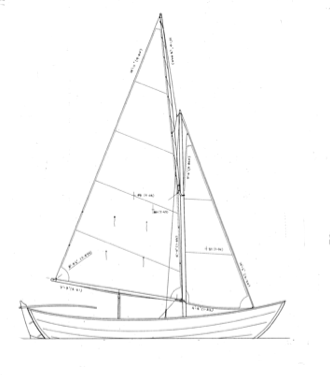
Sailboats - Daysailers
14' 6" whilly boat.
Considered a smaller version of the well-loved Calendonia Yawl, the Whillyboat also takes its cues from traditional Norwegian small craft, and is an ideal daysailer.
Building won't be at all daunting, as she's glue-lap-ply construction, and upkeep will be a snap.
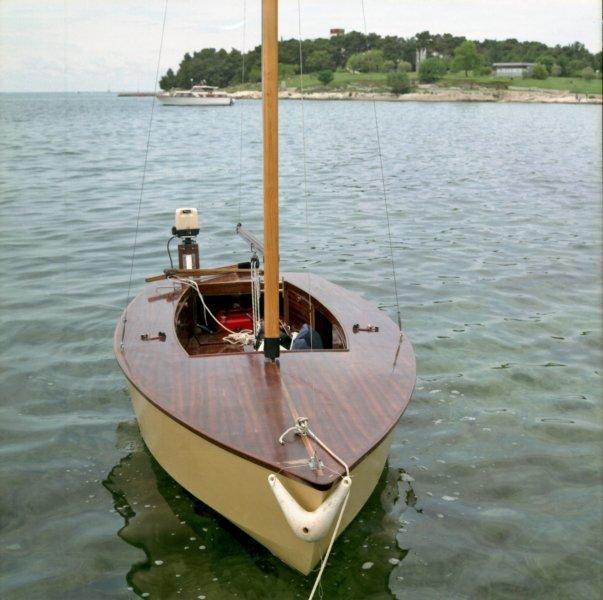
Chesapeake Crab Skiff
Based on traditional crabbing skiff documentation by Howard Chapelle, this has proven to be a fast and stable boat that can carry a real load.
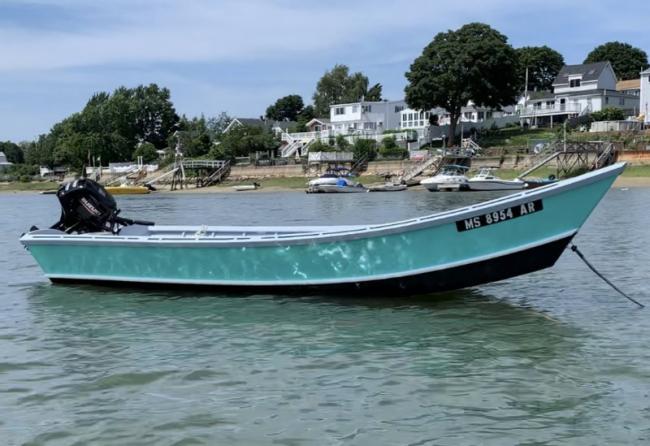
Motorboats - Outboard
World boat skiff 18.
Design Specs: Flat Bottom Open Boat LOA. 17′-3″ (5.2m) Beam 6′ (1.8m) Weight 450 lbs (204 kg) Material Plywood, Hard Wood Fiberglass, Other. Recommended hp. 25
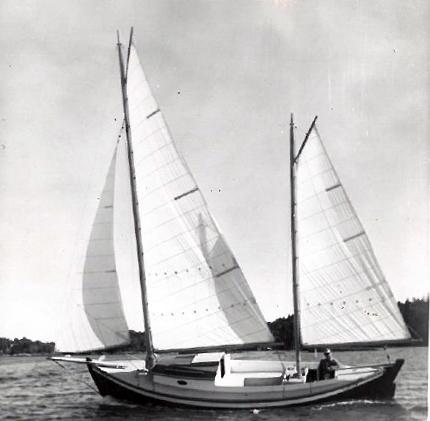
Sailboats - Cruising
26′ Auxiliary KetchBased on a traditional fishing vessel type called a “Cowhorn” this design features an inboard engine and ballast keel.The arrangement provides two berths, a head and modest galley.
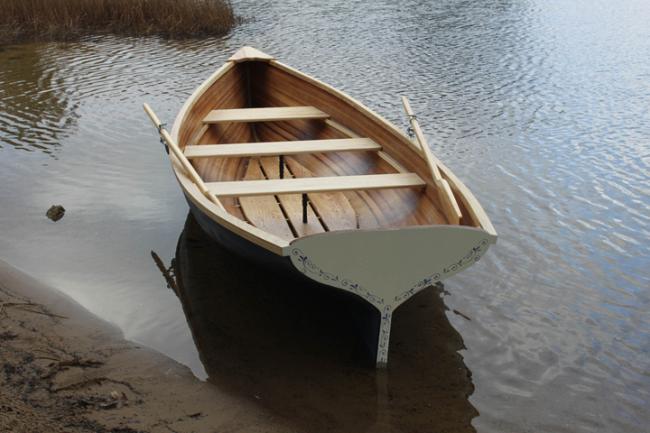
Oar / Paddle
Sandy point boat works whitehall 14.
This 14′ pulling boat was inspired by the Typical Whitehall Designs uses as work boats of the harbors of New York a century ago. Altered to be more of a recreational boat, you will find that pulling the oars on this boat is a delight.
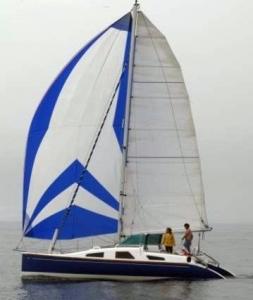
Trailerable cruising catamaran
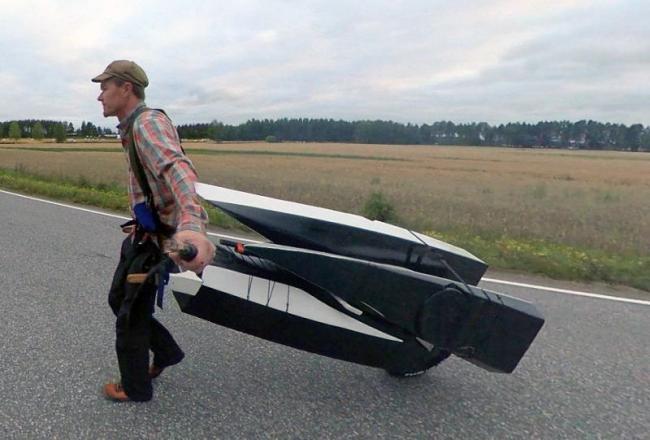
Luonteri is a “trail hiking kayak”, that can be divided into three parts. It makes storage and transportation more easy. In addition, the kayak can be transported as a “cart” with one wheel along roads or trails.
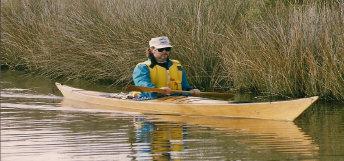
Arctic Hawk
Test the Arctic Hawk on the worst conditions and you will find it at its best.The Arctic Hawk is a medium volume, touring kayak which recreates the legendary West Greenland kayak in today's material and technology. The West Greenland design was bred in adversity and perfected in storm and ice.
Share your boatbuilding plans or kits today.
Login Sign up
From the Community
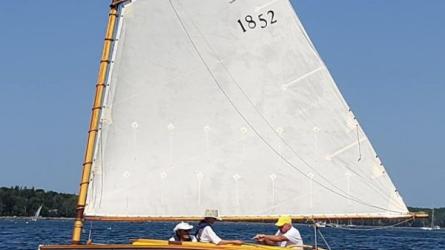
UNA Catboat Replica
16′ gaff-rigged “skimming-dish” catboat, 1852 design by Cat. Robert “Bob” Fish. 247 sq. ft.
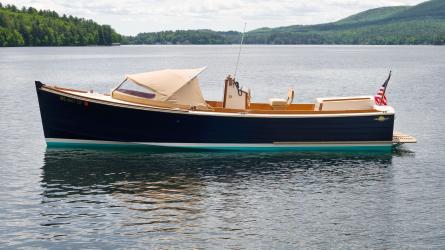
2016 First Light Monomoy 24'
Seabreeze is well-maintained and in like new condition.
1986 21' Staudacher Runabout
Discover a Timeless Classic - 1986 Staudacher Wooden Runabout.
Register of Wooden Boats
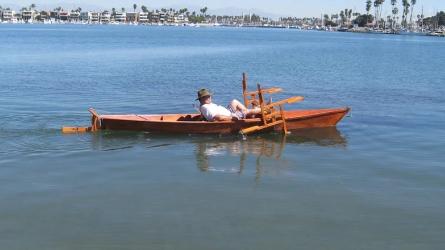
Light Simple Dory (LSD)
I love my LSD!
From Online Exclusives
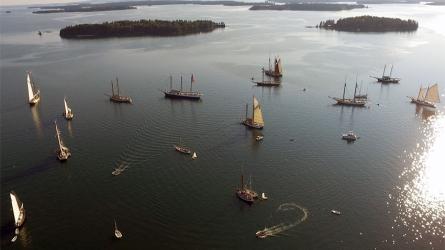
2017 Maine Windjammer Schooner Sail-In
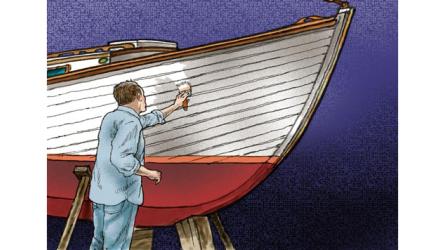
Ten Things That Can Hurt Your Wooden Boat
Whiskey plank.
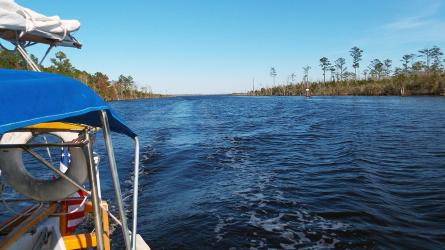
The Delivery from Hell—Part Three: Virginia to North Carolina
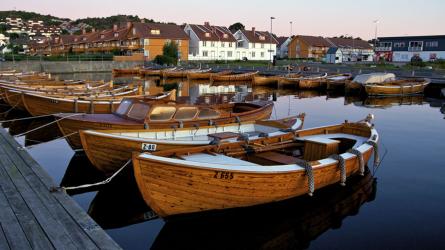
TRI-STAR 24
Tri-star 25.
TRI-STAR 25 Study Plans $40.00 Add To Cart TRI-STAR 25 Plans $550.00 Add To Cart
TRI-STAR 26 MT
Tri-star 27-9, tri-star 31, tri-star 31 cm.
TRI-STAR 31CM Study Plans $40.00 Add To Cart TRI-STAR 31CM Plans $600.00 Add To Cart
TRI-STAR 32 XR
TRI-STAR 32XR Study Plans $40.00 Add To Cart TRI-STAR 32XR Plans $600.00 Add To Cart
TRI-STAR 35
TRI-STAR 35 Study Plans $ 40.00 Add To Cart TRI-STAR 35 Plans $ 650.00 Add To Cart
TRI-STAR 35 XR
TRI-STAR 35 XR Study Plans $40.00 Add To Cart TRI-STAR 35 XR Plans $700.00 Add To Cart
TRI-STAR 36
Tri-star 37 xrc.
TRI-STAR 37 XRC Study Plans $ 40.00 Add To Cart TRI-STAR 37 XRC Plans $ 800.00 Add To Cart
TRI-STAR 38 / 39
Tri-star 40 lw, tri-star 42, tri-star 43 xrc, tri-star 43 mc, tri-star 44 lw, tri-star 45, tri-star 49, tri-star 50, tri-star 51 mc, tri-star 54, tri-star 60 / 63, tri-star 65, tri-star 80, tri-star 104.
Email us for availability and prices
12 Scarab 350; Ray Kendrick; Small Tri; Ply Plans ; Team Scarab
12 Solo 12; Chris Ostlind; Personal Tri; Ply Plans ; Duckworks
14 Docat; Paul Fisher; Dory Catamaran; Ply Plans ; Duckworks 14 Drifter; Mark Gumprecht; Outrigger/Tri; Ply Plans ; Duckworks 14 Duo 425; Bernd Kohler; Fast Cat; Ply Plans ; K - Designs 14 Fast Twin; Hartley & Brookes; Family Cruising Cat; Ply/GRP Plans ; Hartley & Brookes 14 Hitia; James Wharram; Small Cat; Ply Plans ; James Wharram Designs 14? Hobby Cat; at The Beachcats.com; Beach Cat; Ply Plans (Free) ; at The Beachcats.com 14 Pixie; Woods Designs; Entry level fun cat; Ply Plans ; Duckworks 14 Quattro 14; Woods Design; Twin trapeze racer; Ply Plans ; Duckworks 14 Solo 14; Chris Ostlind; Personal Tri; Ply Plans ; Duckworks

15 SC435; Bernd Kohler; Beach Cat; Ply Plans ; K - Designs
16 Trimaran; Kurt Hughes; Two Man Tri; Ply Plans ; Kurt Hughes 16 Blue Joseph; John McCallum; Proa; Ply Plans ; Applegate Boatworks 16 Drifter; Mark Gumprecht; Outrigger/Tri; Ply Plans ; Duckworks 16 Duo 480; Bernd Kohler; Cat; Ply Plans ; Ikarus 16 Fast Twin; Hartley & Brookes; Family Cruising Cat; Ply or GRP Plans ; Hartley & Brookes 16 Hot Chili; Jeff Gilbert; Asymmetric Cat; ply Plans ; Duckworks 16 Jarcat5; Ross Turner; Trailer Sailer; Ply Plans ; Ross Turner 16 La Chatte; Glen-L; Beach Cat; Ply Plans ; Glen-L 16 Little Tri; Bernd Kohler; Small Trimaran; Ply Plans ; Duckworks 16 Melanesia; James Wharram; Small Cat; Ply Plans ; James Wharram Designs 16 Quattro 16; Woods Designs; Twin trapeze racer; Ply Plans ; Duckworks 16 Scarab 16; Ray Kendrick; Folding Tri; Ply Plans ; Team Scarab 16 Simple Surf; Paul Fisher; Day Sailer; Ply Plans ; Duckworks 16 Slider Cat; Ray Aldridge; Sit in Hull Cruising Cat; Ply Plans ; Duckworks 16 Slingshot 16; Smoot/Walters; Trimaran; Ply Plans ; Duckworks 16 Trilars; Jim Michalak; Outrigger Canoe; Ply Plans ; Duckworks

17 Hitia; James Wharram; Small Cat; Ply Plans ; James Wharram Designs 17 Rebel Cat; PVC Cat; PVC Plans ; Duckworks 17 W17; Mike Waters; Folding Trimaran; Ply Plans ; Small Trimaran Designs
18 A18-T; Chris Ostlind; Tri; Ply Plans ; Duckworks 18 Eco Cruiser; Bernd Kohler; Cruising Cat; Ply Plans ; K - Designs 18 Fast Twin; Hartley & Brookes; Family Cruising Cat; Ply or GRP Plans ; Hartley & Brookes 18 Hawk; Paul Fisher; Beach Cat; Ply Plans ; Duckworks 18 Rapier; Malcolm Tennant; Racer; Ply Plans ; Malcolm Tennant 18 Rodcat; Paul Fisher; Racer; Ply Plans ; Duckworks 18 Scarab 18; Ray Kendrick; Folding Tri; Ply Plans ; Team Scarab 18 Strike; Woods Design; Trimaran; Plywood Plans ; Duckworks 18 Tricky Five, BCA Demco; Catamaran; Ply Plans ; Duckworks
19 Cat19; Selway/Fisher; Demountable Cat; Ply Plans ; Duckworks 18 Double Shuffle 5.6; Ray Kendrick; Cat; Ply Plans ; Team Scarab 19 Trikala; Kurt Hughes; Trailer Tri; NA Plans ; Kurt Hughes

20 Discovery; Chris White; Pocket Cruising Tri; Wood/Epoxy/Ply Plans ; Chris White 20 Eco 6; Bernd Kohler; Crusing Cat; Ply Plans ; K - Designs 20 Gizmo; Michalak; Proa; Ply Plans ; Duckworks 20 Threefold 6; Dudley Dix; Folding Tri; Ply Plans ; Duckworks 20 Trimaran; Kurt Hughes; Two Person Tri; Ply Plans ; Kurt Hughes 20 Turbo 6; Malcolm Tennant; Fast Camp Cruiser; Wood Epoxy Plans ; Malcolm Tennant 20 Worrell 1 Mk2; Graham Byrnes; Beach Cat; Ply Plans ; B&B Yacht Design
21 A64; Chris Ostlind; Proa; Ply Plans ; Duckworks 21 Crabclaw Cat; Shell Boats; Crabclaw Rigged; Ply Plans ; Shell Boats 21 Tahiti Wayfarer; James Wharram; Cat; Ply Plans ; James Wharram Designs 21 Tiki; James Wharram; Cat; Ply Plans ; James Wharram Designs 21 Tiny Dancer; Ted Warren; Personal Proa; NA Plans/Kit ; Warren Multihulls 21 Tridarka Raider; Jeff Lehman; Sailing Tri; Ply Plans ; Platypus Boats 21 Warren 21 Proa; Ted Warren; Proa; NA Plans ; Warren Multihulls

22 DUO 660; Bernd Kohler; Fast Trailer catamaran; Ply Plans ; K - Designs 22 Janus; Woods Designs; Micro Cruiser; Ply Plans ; Duckworks 22 KD 650; Bernd Kohler; Coastal Trailer Cat; Ply Plans ; K - Designs 22 Scarab 650; Ray Kendrick; Tri; Ply Plans ; Team Scarab 22 Scarab 670; Ray Kendrick; Folding Tri; Ply Plans ; Team Scarab 22 Scarab 22; Ray Kendrick; Tri; Ply Plans ; Team Scarab 22 Wizard; Woods Designs; Folding Micro; Cedar Strip or GRP Plans ; Woods Designs 22 Wizzer; Woods Design; Racing Micro; Strip Cedar or GRP Plans ; Woods Design
23 Chevron; Malcolm Tennant; Trailer Cat; Strip Plank Plans ; Malcolm Tennant 23 Hinemoa; James Wharram; Dayboat/Overnight Cat; Ply Plans ; James Wharram Designs 23 Konktiki 23; Catamaran Designs; Sailing Cat; Ply Plans ; Catamaran Design 23 Streaker; Malcolm Tennant; Performance Cat; Strip Plank Plans ; Malcolm Tennant 23 Trailerable Tri; Kurt Hughes; Pocket Cruiser; NA Plans ; Kurt Hughes 23 Warren 23; Ted Warren; Fast Tri Daysailer; NA Plans ; Warren Multihulls
24 Coral Coast 24; Ross Turner; Coastal Cruiser; Ply Plans ; Ross Turner 24 DK24; Dennis Davis; Solo Trimaran; Ply Plans ; Dennis Davis Designs 24 Strider; Woods Design; Classic; Cold Mold, Strip, GRP Plans ; Duckworks 24 Shadow; Woods Design; Cruiser; Cold Mold, Strip, GRP Plans ; Duckworks
25 Cat 25; Paul Fisher; Class Racer; Ply Plans ; Duckworks 25 Eco 7.5; Bernd Kohler; Economy Cruising Cat; Ply Plans ; K - Designs 25 Gwahir; Woods Design; Micro Racer; Cold Molded or Strip Cedar Plans ; Woods Design 25 Trillo, BCA Demco; Catamaran; Ply Plans ; Duckworks

26 Coaster; Malcolm Tennant; Coastal Cruiser; Strip Plank Plans ; Malcolm Tennant 26 Merlin; Woods Design; Micro Racer; Strip Cedar Plans ; Woods Design 26 Pahi; James Wharram; Wingsail Cat; Ply Plans ; James Wharram Designs 26 Proa; Kurt Hughes; Cruiser; Ply Plans ; Kurt Hughes 26 Scarab 8.0; Ray Kendrick; Folding Tri; Ply Plans ; Team Scarab 26 Spyder MKII; Malcolm Tennant; Class Racer; Strip Plank Plans ; Malcolm Tennant 26 Tiki; James Wharram; Cat; Ply Plans ; James Wharram Designs 26 Trailerable Trimaran; Kurt Hughes; Tri; Ply Plans ; Kurt Hughes
27 Cat 254; Paul Fisher; Class Racer; Ply Plans ; Duckworks 27 Demountable Cat; Kurt Hughes; Cruiser; NA Plans ; Kurt Hughes 27 DUO 800; Bernd Kohler; Fast Coastal Trailer Sailer Cat; Ply Plans ; K - Designs 27 F-25C; Ian Farrier; Fast Trailerable Trimaran; Composite Plans ; Farrier Marine 27 F-82; Ian Farrier; Fast Cruising Trimaran; Strip Plank, or Foam Core Plans ; Farrier Marine 27 F-82R; Ian Farrier; Fast Cruising Trimaran; Foam Core Plans ; Farrier Marine 27 KD800; Bernd Kohler; Folding Cat; Ply/Strip Plans ; K - Designs 27 Warren 27; Ted Warren; Fast Tri Daysailer; NA Plans ; Warren Multihulls

28 Great Barrier Express; Malcolm Tennant; Open Wing Deck Cat; Strip Plank Plans ; Malcolm Tennant 28 Gypsy 28; Woods Design; Ocean Cruiser; Ply, GRP Panel Plans ; Woods Design 28 Lively; Hartley & Brooks; Family Cruiling Tri; Ply Plans ; Hartley & Brooks 28 Stinger MKII; Malcolm Tennant; Formula 28 Racer; Strip Plank Plans ; Malcolm Tennant 28 Surfsong; Woods Design; Performance Cruiser; Ply or GRP Plans ; Woods Design 28 Sylph; Malcolm Tennant; Folding Tri; Strip Plank Plans ; Malcolm Tennant
29 Coral Coast 29; Ross Turner; Offshore Cruiser; Ply Plans ; Ross Turner 29 KD 860; Bernd Kohler; Offshore Cruising Cat; Ply Plans ; K - Designss 29 Tanenui; James Wharram; Cruising Cat; Ply/Foam Plans ; James Wharram Designs
30 Avalon 9.0; Ray Kendrick; Folding Tri; Ply Plans ; Team Scarab 30 Catamaran; Kurt Hughes; Cruising Cat; Ply Plans ; Kurt Hughes 30 Demountable 30; Kurt Hughes; Trailer Cruising Tri; Ply Plans ; Kurt Hughes 30 Demountable Cat; Kurt Hughes; Trailer Cruiser; Ply Plans ; Kurt Hughes 30 DUO 900; Bernd Kohler; Cruiser/Racer Trailer Cat; Ply Plans ; K - Designs 30 Sagitta 30; Woods Design; Performance Cruiser; Strip Plank or GRP Plans ; Woods Design 30 Shilo; Malcolm Tennant; Solid Wing Cruising Cat; Strip Plank Plans ; Malcolm Tennant 30 Skua; Woods Design; Trailerable Racer; Cedar Strip or Cold Molded Plans ; Woods Design 30 Tiki; James Wharram; Trailerable Cat; Ply Plans ; James Wharram Designs 30 Tomcat; Kurt Hughes; High Performance; Ply Plans ; Kurt Hughes 30 Turissimo 9; Malcolm Tennant; Cruising Cat; Strip Plank Plans ; Malcolm Tennant
31 F9-A; Ian Farrier; Trailerable Cruiser; Composite Plans ; Farrier Marine 31 D-30; Kurt Hughes; Trailerable Tri; Ply Plans ; Kurt Hughes 31 D-30 Aft Cabin; Kurt Hughes; Trailerable Tri; Ply Plans ; Kurt Hughes 31 DF-31; Kurt Hughes; Aft Cabin Trailer Tri; Composite Plans ; Kurt Hughes 31 Firebird; Malcolm Tennant; Racing Tri; Strip Plank Plans ; Malcolm Tennant 31 Javelin; Woods Design; Minimum Offshore Racer; Strip Cedar or GRP Plans ; Woods Design 31 Pahi; James Wharram; Offshore Cruiser; Ply Plans ; James Wharram Designs 31 Scorpio; Woods Design; Minimun Offshore Cruiser; Strip Cedar or GRP Plans ; Woods Design 31' Trimaran; Kurt Hughes; Sliding Arm Tri; Composite Plans ; Kurt Hughes 31 Tiki; James Wharram; Workboat Cat; Ply Plans ; James Wharram Designs 31 Windsong; Woods Design; Minimun Offshore Cruiser; Ply or GRP Plans ; Woods Design

32 Chrome 96; Malcolm Tennant; Cruising/Racing Tri; Strip Plank Plans ; Malcolm Tennant 32 D-32; Kurt Hughes; Trailerable Cruising Tri; Ply Plans ; Kurt Hughes 32 P95; Bernd Kohler; Fast Cat; Ply Plans ; K - Designs 32 Red Shift; Malcolm Tennant; Cruising/Racing Cat; Strip Plank Plans ; Malcolm Tennant
33 Portage 10; Malcolm Tennant; Solid Wing Cruising Cat; Strip Plank Plans ; Malcolm Tennant 33 Trimaran 10; Angelo Lavranos; Fast Cruiser; Composite Kit ; Lavranos Marine Design 33 Turissimo 10 MKII; Malcolm Tennant; Performance Cruising Cat; Strip Plank Plans ; Malcolm Tennant 33 Vermillion; Malcolm Tennant; Open Wing Racing/Cruising Cat; Strip Plank Plans ; Malcolm Tennant
34 Flica 34; Woods Design; Offshore Cruiser; Ply or GRP Plans ; Woods Design 34 Hammerhead; Chris White; Cruising Tri; Plans ; Chris White Designs 34 Lively; Hartley & Brooks; Ocean Cruising Tri; Ply Plans ; Hartley & Brooks

35 Crazy Horse; Malcolm Tennant; Racing Cat; Strip Plank Plans ; Malcolm Tennant 35 Cruising Tri; Kurt Hughes; Cruiser; Ply Plans ; Kurt Hughes 35 Proteus 10.6; Angelo Lavranos; Cruising Cat; Ply CNC Kit Set Kit ; Lavranos Marine Design 35 Warren 35; Ted Warren; Trailerable Fast Cruising Tri; NA Plans ; Warren Multihulls
36 Cruising Cat; Kurt Hughes; Cruiser; Ply or Composite Plans ; Kurt Hughes 36 Demoiselle; Malcolm Tennant; Cruising/Racing Tri; Strip Plank Plans ; Malcolm Tennant 36 Mira; Woods Design; Offshore Cruiser; Strip Cedar, Ply, or GRP Plans ; Woods Design 36 Northern; Malcolm Tennant; Open Wing Cruising Cat; Composite Plans ; Malcolm Tennant 36 Nui Guinea MK 2; Malcolm Tennant; Ocean Cruising Cat; Strip Plank Plans ; Malcolm Tennant 36 Raka; James Wharram; Cruising/Racing Cat; Ply Plans ; James Wharram Designs 36 Scylla; Woods Design; Performance Cruiser; Strip Cedar or GRP Plans ; Woods Design 36 Seagull; Bernd Kohler; Long Distance Cruising Cat; Ply Plans ; K - Designs 36 Tangaroa MKIV; James Wharram; Cruising Cat; Ply Plans ; James Wharram Designs 36 Vorpal Blade MK 2; Malcolm Tennant; Cruising/ Racing Cat; Strip Plank Plans ; Malcolm Tennant
37 Catamaran; Kurt Hughes; Bridge Deck Cat; Composite Plans ; Kurt Hughes 37 F-36; Ian Farrier; Blue Water Cruising Trimaran; Composite Plans ; Farrier Marine 37 Northern - 11; Malcolm Tennant; Open Wing Cruising Cat; Strip Plank Plans ; Malcolm Tennant

38 Backpack 38; Dudley Dix; Tropical Cruising Cat; Ply or GRP Plans ; Dix Design 38 Catamaran; Kurt Hughes; Cruiser; Ply Plans ; Kurt Hughes 38 Catamaran; Kurt Hughes; Fast Cat; Composite Plans ; Kurt Hughes 38 Demountable Tri; Kurt Hughes; Cruiser; Ply & Composite Plans ; Kurt Hughes 38 Pelican; Bernd Kohler; Offshore Cruising Cat; Ply Plans ; K - Designs 38 Rigger; Malcolm Tennant; Serious Cruising Cat; Wood Plans ; Malcolm Tennant 38 Sienna ; Malcolm Tennant; Ocean Cruising Cat; Strip Plank Plans ; Malcolm Tennant 38 Tiki; James Wharram; Traditional Wharram Cat; Ply Plans ; James Wharram Designs 38 Tri; Kurt Hughes; Flared Main Hull Tri; Composite Plans ; Kurt Hughes
39 Altair; Malcolm Tennant; Cruising Cat; Strip Plank Plans ; Malcolm Tennant 39 Cat 39; Bruce Roberts; Cruiser; GRP Plans ; Bruce Roberts Designs 39 Jayar; Malcolm Tennant; Ocean Cruising Cat; Strip Plank Plans ; Malcolm Tennant 39 Rigger; Malcolm Tennant; Serious Cruiser; Wood Plans ; Malcolm Tennant 39 Targa; Malcolm Tennant; Ocean Cruising/Racing Cat; Strip Plank Plans ; Malcolm Tennant 39 Thresher; Malcolm Tennant; Coastal Racer/Cruiser; Strip Plank Plans ; Malcolm Tennant 39 Valencia ; Malcolm Tennant; Cruising Cat; Strip Plank Plans ; Malcolm Tennant
40 Alfresco 40; Malcolm Tennant; Solid Wing Cruising Cat; Strip Plank Plans ; Malcolm Tennant 40 Bridgedeck Cat; Kurt Hughes; Cruiser; Composite Plans ; Kurt Hughes 40 Cat 40; Paul Fisher; Cruising Cat; Ply Plans ; Duckworks 40 Child of the sea; James Wharram; Cat; Ply Plans ; James Wharram Designs 40 Double Eagle; Phil Bolger; Charter Cat; Ply Project ; Fritz Koschmann 40 Formula 40; Kurt Hughes; Racing Tri; Ply or Composite Plans ; Kurt Hughes 40 Narai I, II; James Wharram; Cruising Cat; Ply Plans ; James Wharram Designs 40 Pacific 40; Malcolm Tennant; Cruising Cat; Strip Plank Plans ; Malcolm Tennant 40 Trimaran; Kurt Hughes; Flared Main Tri; Composite Plans ; Kurt Hughes 40 Wild Thing; Malcolm Tennant; Racing Tri; Strip Plank Plans ; Malcolm Tennant
41 Meander; Woods Design; Offshore Cruiser; Cold Molded, Ply or GRP Plans ; Woods Design 41 Narai III; James Wharram; Cruising; Ply Plans ; James Wharram Designs 41 Nimbus; Woods Design; Offshore Cruiser; GRP Plans ; Woods Design 41 Rhea; Woods Design; Offshore Cruiser; Strip Cedar or GRP Plans ; Woods Design

42 F-41; Ian Farrier; Ocean Cruising Cat; Composite Plans ; Farrier Marine 42 Manta; Bernd Kohler; Offshore Cruising Cat; Ply Plans ; K - Designs 42 Pahi; James Wharram; Deck Pod Offshore Cruiser; Ply Plans ; James Wharram Designs
43 Blade Runner; Malcolm Tennant; Racing Cat; Wood Plans ; Malcolm Tennant 43 Dix 430; D Dix; Cruising Catamaran; GRP or Wood/epoxy Plans ; Dix 43 Indigo 43; Malcolm Tennant; Charter Cat; Plans ; Malcolm Tennant 43 Te Henga MK 2; Malcolm Tennant; Cruising Cat; Strip Plank Plans ; Malcolm Tennant
44 Explorer; Chris White; Cruising Tri; GRP Plans ; Chris White Designs
45' Bridgedeck Cruising Cat; Kurt Hughes; Cat; Composite Plans ; Kurt Hughes 45 Fast Cruising Cat; Kurt Hughes; Fast Cat; Composite Plans ; Kurt Hughes 45 Tiros; Malcolm Tennant; Ocean Racing Cat; Strip Plank Plans ; Malcolm Tennant

46 Aluminium 13.8; Angelo Lavranos; Cruising Cat; Alum Kit Set Kit ; Lavranos Marine Design 46 Araki; James Wharram; Cruising/Racing; Ply Plans ; James Wharram Designs 46 Big Wednesday; Malcolm Tennant; Cruising/Racing Cat; Strip Plank Plans ; Malcolm Tennant 46 Catamaran Motorsailer; Kurt Hughes; Cat; Composite Plans ; Kurt Hughes 46 Dorsai; Malcolm Tennant; Ocean Racing Cat; Strip Plank Plans ; Malcolm Tennant 46 Ondina; Woods Design; Offshore Cruiser; Ply Plans ; Woods Design 46 Sundiver; Malcolm Tennant; Motor Sailing Cat; NA Plans ; Malcolm Tennant 46 Tasman; Malcolm Tennant; Ocean Cruising Cat; Strip Plank Plans ; Malcolm Tennant 46 Tiki; James Wharram; Blue Water Cat; Ply Plans ; James Wharram Designs 46 Timeliner 46; Malcolm Tennant; Cruising Cat; Wood Epoxy Plans ; Malcolm Tennant
47 Cirrus; Woods Design; Offshore Cruiser; Cold Molded or GRP Plans ; Woods Design
48 Catamaran; Kurt Hughes; Cat; Composite or Ply Plans ; Kurt Hughes 48 Voyager; Chris White; Cruising Cat; GRP Plans ; Chris White Designs

49 Challenger; Malcolm Tennant; Ocean Racing Cat; Strip Plank Plans ; Malcolm Tennant 49 Ghanian; Malcolm Tennant; Fast Cruising Cat; Strip Plank Plans ; Malcolm Tennant 49 Marshan; Malcolm Tennant; Ocean Cruising Cat; Strip Plank Plans ; Malcolm Tennant
50 Hi-Octane; Malcolm Tennant; Racing Cat; Strip Plank Plans ; Malcolm Tennant 50 Tektron 50; John Shuttleworth; High Performance Racer/Cruiser; Composite Plans ; John Shuttleworth Yacht Design
51 Tehini; James Wharram; Cruising Cat; Ply Plans ; James Wharram Designs
52 Tektron Aerorig Cruising Cat; John Shuttleworth; Cruiseing Cat; Composite Plans ; John Shuttleworth Yacht Design 52 Trimaran; Kurt Hughes; Tri; Ply Plans ; Kurt Hughes

53 Cruising Catamaran; Kurt Hughes; Bridgedeck; Composite Plans ; Kurt Hughes 53 Sounder MS; Malcolm Tennant; Motor Sailing Cat; NA Plans ; Malcolm Tennant 53 Thai; Malcolm Tennant; Motor Sailing Cat; NA Plans ; Malcolm Tennant
54 Hammerhead; Chris White; Cruising Tri; Plans ; Chris White Designs 54 Juniper II; Chris White; Cat-Ketch Tri; Wood Plans ; Chris White Designs
56 Cruising Catamaran; Kurt Hughes; Bridgedeck; Plywood Plans ; Kurt Hughes 56 Catamaran; Kurt Hughes; Racer; Composite Plans ; Kurt Hughes
58 Catamaran; Kurt Hughes; Cat; Composite Plans ; Kurt Hughes
60 Catamaran; Kurt Hughes; Charter Cat; Composite or CM Plans ; Kurt Hughes 60 Cordova; Malcolm Tennant; Motor Sailing Cat; NA Plans ; Malcolm Tennant 60 Disco Volante; Malcolm Tennant; Ocean Racing Proa; Strip Plank Plans ; Malcolm Tennant
63 Catamaran; Kurt Hughes; Cat; Composite Plans ; Kurt Hughes 63 Concept 63; Chris White; Cruising Cat; GRP Plans ; Chris White Designs 63 Pahi; James Wharram; Offshore Cruiser; Ply Plans ; James Wharram Designs 63 Revolution; Malcolm Tennant; Wind Turbine Cat; Strip Plank Plans ; Malcolm Tennant 63 Trimaran; Kurt Hughes; Racer; Foam Glass Plans ; Kurt Hughes

65 Cat 65; Bruce Roberts; Charter; GRP Plans ; Bruce Roberts 65 Cruising Catamaran; Kurt Hughes; Cat; CM or Composite Plans ; Kurt Hughes
72 Carillion; Malcolm Tennant; Ocean Motor Sailing Cat; NA Plans ; Malcolm Tennant
82 Cyan; Malcolm Tennant; Ocean Cruiser; NA Plans ; Malcolm Tennan

- Plans & Kits
- Plans by type
- Qty in Cart

DUO 900 Study Plans

DUO 900 Plans
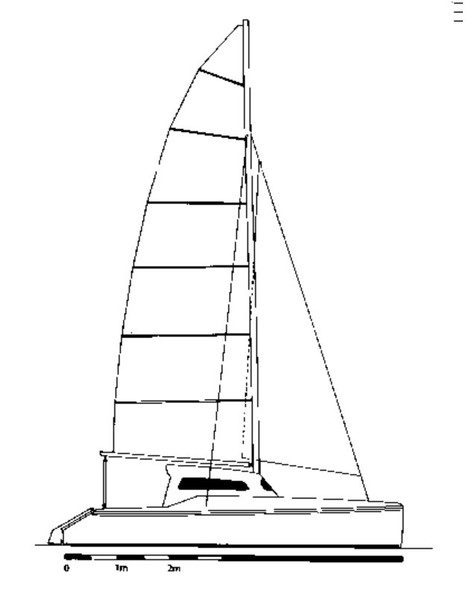
Wizard Study Plans Download

Wizard Plans Download
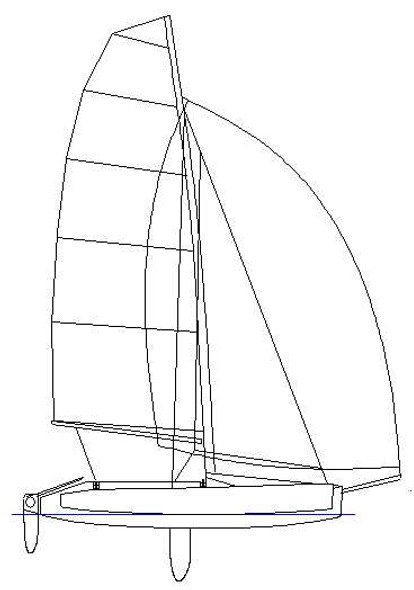
Strike 20 racing trimaran using a F18 beach cat for hulls and rig
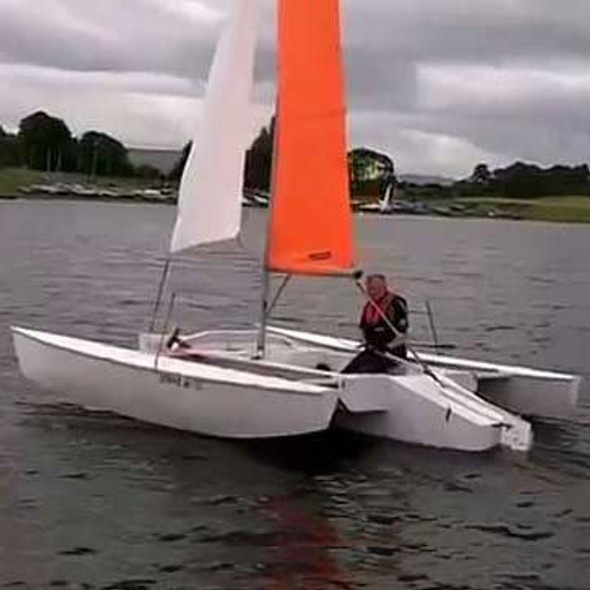
Strike 16 Main Hull Only Plans Download
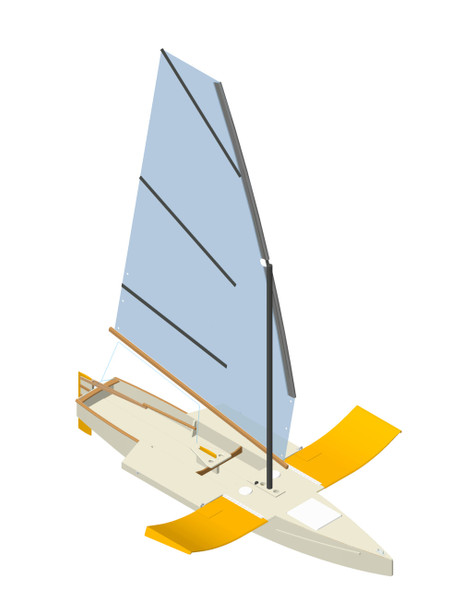
Wingmaran 15 Study Plans Download

Wingmaran 15 Plans and Templates Download
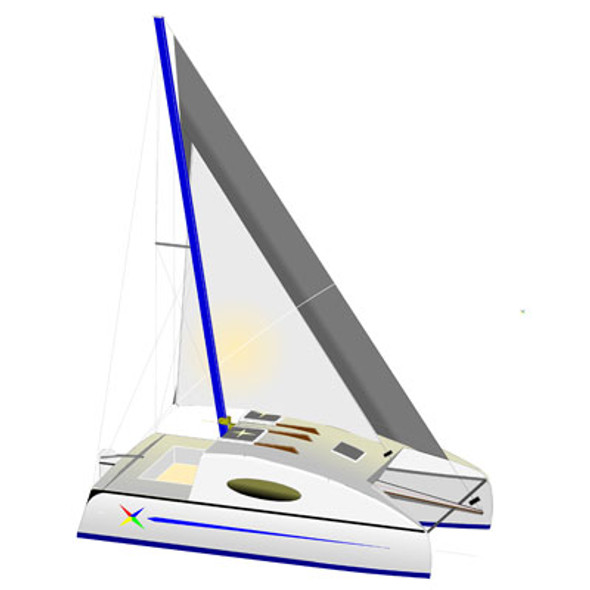
ECO 520 PDF

MaXi The Cat Plans PDF

Janus (full plans) Download
5m rodcat beach catamaran plans.
- Total: items /
- Add all to cart
Adding your products to cart

IMAGES
VIDEO
COMMENTS
We provide stock boat plans for both monohull and multihull sailing vessels, including sailing skiffs and sharpies. Our designs mainly feature timber construction, in plywood or cedar strip plank composite construction, using the W.E.S.T. system (wood epoxy saturation technique). Our designs are intended mainly as cruising boats, although ...
If you were to build a 40-foot (12.1-meter) catamaran, your cost of materials would range between 20-30% of the total cost. Therefore, for $300,000 total, the boat's materials would range between $60,000 and $90,000. The hull tends to range between 15-35% of the total build.
The plans are well detailed, and easy to understand. ... The cross-beams are made of wood using a box-type technique, similar to wooden mast building. Boat Plans. Study Plans. AUD$70. ... coastal sailing catamaran. Multichine 28 - 9.20 m (30.2 ft) blue water cruising sailboat. Multichine 31 - 9.45 m (31.0 ft) blue water cruising sailboat.
Affordable. Building your own boat with Wharram Designs is the easiest and most cost effective way to fulfil your sailing dreams. Wharram Self-build boat plans start from only £120. Wharram designs are based on years of practical, hands-on experience of building and ocean sailing catamarans. They are renowned for their seaworthiness, stability ...
MULTIHULL BOAT PLANS by MIKE WALLER YACHT DESIGNER. TC670 TRAILER CAT. This is an all plywood, trailerable, of the beach sailing cat designed for sheltered and semi-sheltered waters. The cabin has a double berth, a galley, small table area and W.C. TC750 CATAMARAN. This all plywood cat is a larger and more able development of the 670, and being ...
10ft 2 sheet ply Duo dinghy. 24ft Strider sailing fast. 36ft Mirage open deck catamaran. All Our Designs. Woods Designs specialise in the design of sailing catamarans for both home and professional builders. However we also have a small range of dinghies, trimarans and power catamarans. Scroll down to see the full list, divided into lengths and ...
The WIZARD is a 22ft sailing catamaran design that offers 5-6 berths in 3 cabins, standing headroom, easy trailing, stability AND performance. For the first time in a trailable catamaran there is a genuine double bunk.It is legally trailable world-wide behind a family car. One person can assemble and rig it in under an hour ready for ...
LOA: 15'-6"; LWL : 13'-9"; Beam: 6'-11"; Draft: 10". Weight of structure: 450 Lbs. Materials: Marine plywood, epoxy. Maximum capacity: 8 persons. The Flat Cat hull is a new and efficient concept and is within the capabilities of many amateurs to build. The hull is a "false" catamaran with a tunnel that's partially immersed.
The first step is to decide on the design and the materials you will use. You will need plans for the project, along with lumber and other materials such as fiberglass and epoxy. The next step is to build the catamaran frame, which involves cutting and fitting the wood pieces together to form the hulls and decks.
Sharpie Cat 42. The Sharpie Cat 42 is a new catamaran design from a regular WoodenBoat contributor, author and marine architect Reuel B. Parker. She is a fast cruising cat with accommodations for eight in four cabins. Construction is cold-molded wood/epoxy, with foam core bulkheads, cabins/roofs, and she features a Parker "L-Head" rotating ...
Like most designers we do not offer plans for catamarans built in steel or aluminium. Nearly 3000 plans and over 200 production catamarans have now been sold. Boats are sailing all over the world. Cruisers have made many comfortable ocean crossings in complete safety while the number of trophies won is testament to the speed of the racing designs.
16' Quattro Catamaran. High performance beach cat which is striking to look at and exciting to sail. Well-detailed plans of simple and rugged stitch-and-glue plywood hulls. Construction: Stitch-and-glue plywood over bulkhead frames. No lofting is required. Plans include 2 sheets.
Step 1: Draftsmanship. After poking around online for inspiration and taking heavy influence from the crafts of Jeremy Broun and Tim from Way Out West, I drafted plans for my catamaran. My design, alas, was limited by my amateur woodworking skills and my available tools, leading it to be quite heavy and boxy.
Our construction plans and kits are sold with 100% professional boatbuilder support via phone and email, any time you're unsure or just need a second opinion, we're here. ... Tags: Balsa end grain catamaran material wood (150 kg/cubic metre), Build a boat, build a catamaran, ...
Genuine Hartley Boatplans and Samson Boatplans are only supplied by hartley-boats.com, New Zealand. Catamaran & Trimaran Boat Plans from Hartley Boats make it a reality to build your own multihull at home. Build with Plywood or Fibre Glass. 12-35 ft plans.
The "Classic" trailable catamaran . Specs, plans, building logs, photo and video gallery. Toggle navigation Boatplans.cc Row boat plans ; Sailboat plans ... STRIDER is the most popular of our trailable catamarans as it offers a good compromise ... 2011 changed from a windrush 600 to a wooden Strider. Designed by Richard Woods. This is a wide ...
Everything you need to build your own sea-going catamaran: 3 steps. Familiarise yourself with our range of designs and their unique qualities. For more detailed information read the Wharram Design Book which reviews each self-build boat model and offers a detailed introduction and understanding of the world of self-build catamarans.; Order one or more sets of our Study Plans and immerse ...
POWER CATAMARAN PLANS and KITS, CATAMARAN PLANS , Bruce Roberts WEB SITE offers catamaran boat plans and catamaran boat kits for fiberglasss and aluminum boat designs, cut to size CATAMARAN kits, part built boats or complete boats. Bruce Roberts Yacht Designs offer boat building project management arrangements for boats built overseas at affordable prices.
Home boat building. Step by step how to build a Catamaran. DIY small boat plans. Wooden boat plans. Videos of how I built a Catamaran - 40 ft. A 3 year
Simmons Sea-Skiff Boat Plans. Designer. T. N. Simmons. Interested in building your own boat? Cape Fear Museum in Wilmington, NC sells Simmons Sea-Skiff boat plans in 18′, 20′ and 22′.Thomas Norwood Simmons was born in 1908 in Wilmington and lived most of his life on Myrtle Grove Sound. He was a carpenter by trade. Sailboats - Cruising.
The DESIGNER'S book TRIMARAN and CATAMARAN CONSTRUCTION is part of the plans (over 21') and covers all phases of construction. Plans are leased to build ONE boat, NO time limit. Tri-Star designs are proven designs, sailing the seven seas since 1964. Free consultation is provided to the original non-professional builder till he or she is sailing ...
8. 8-9' RagWing Puddlecats; Roger Mann; Wooden Catamarans; Ply Plans; RagWing Puddlecats. 9. 9 Oppikat; D Dix; Training Catamaran; GRP Plans; Duckworks. 10. 10 P3 ...
DUO 900 Plans For study plans click HERE The DUO 900 is a quick-to-build, open-bridge catamaran with asymmetrical hulls. The boat was designed for a French fighter pilot who lived in Argentina. His goal was to sail from Buenos Aires to Marseille. Looking...